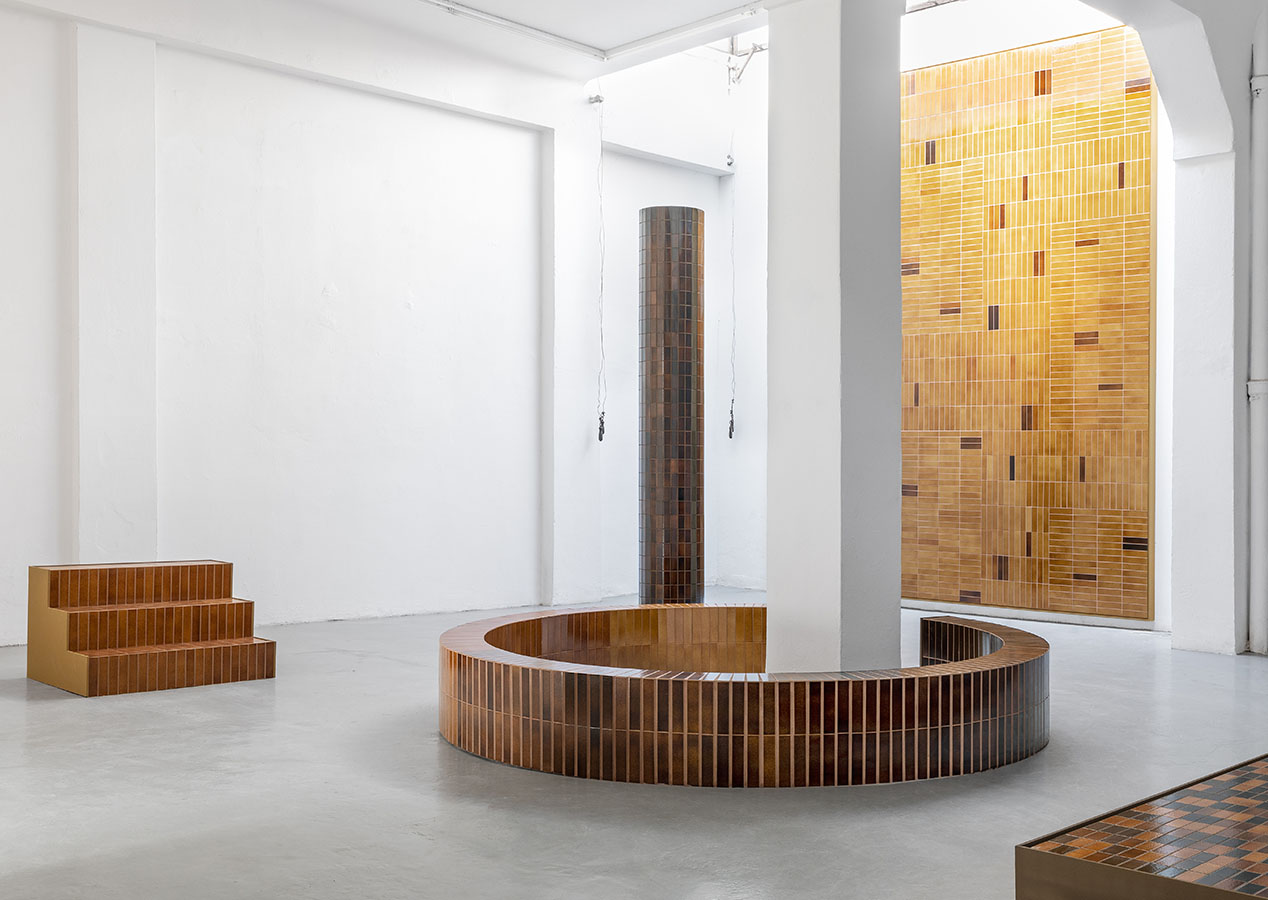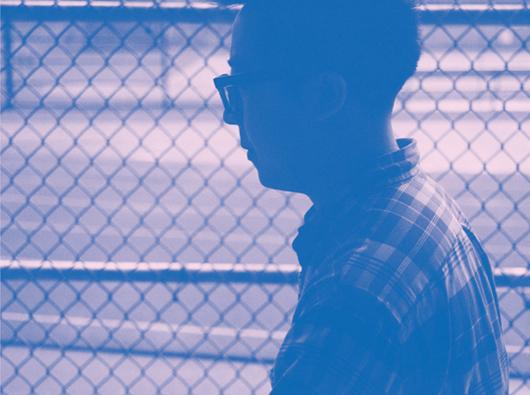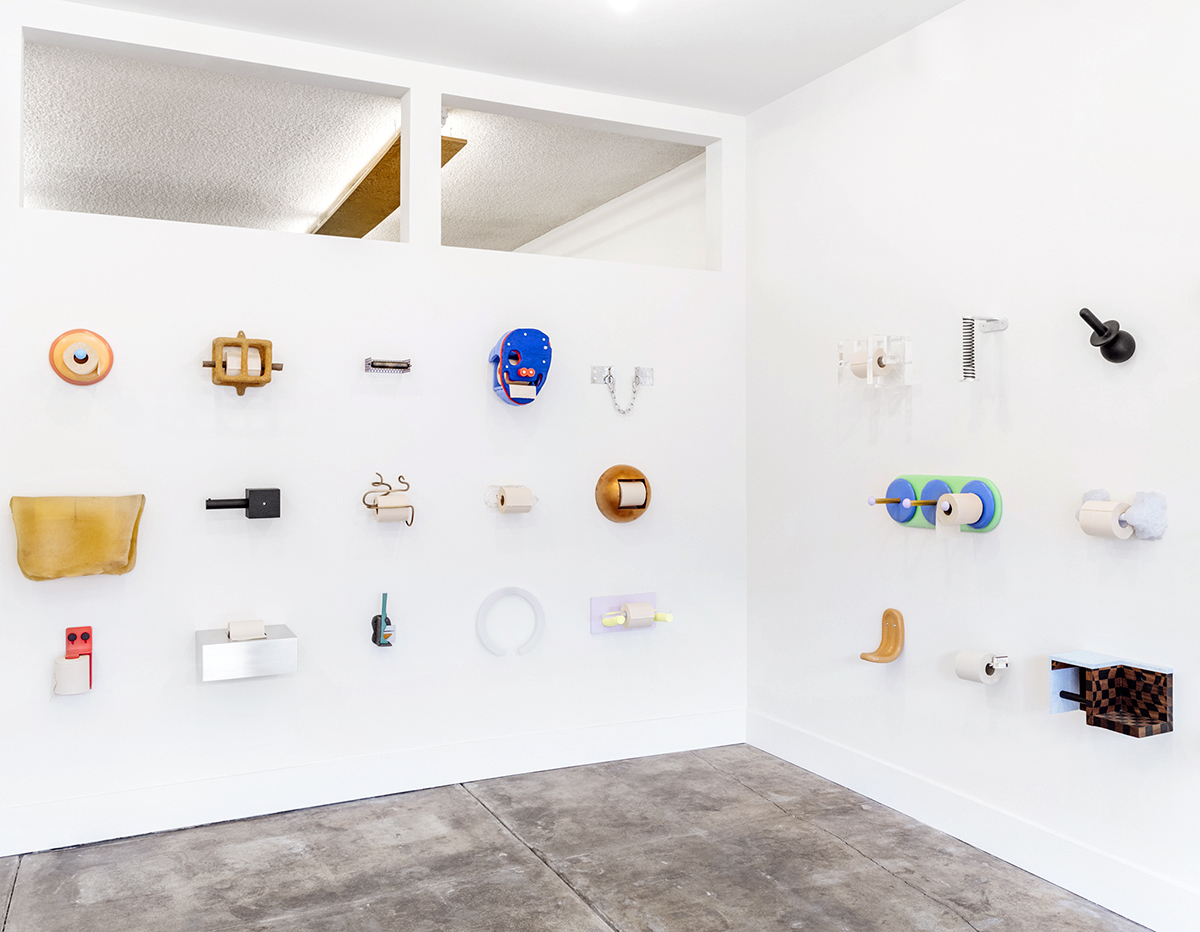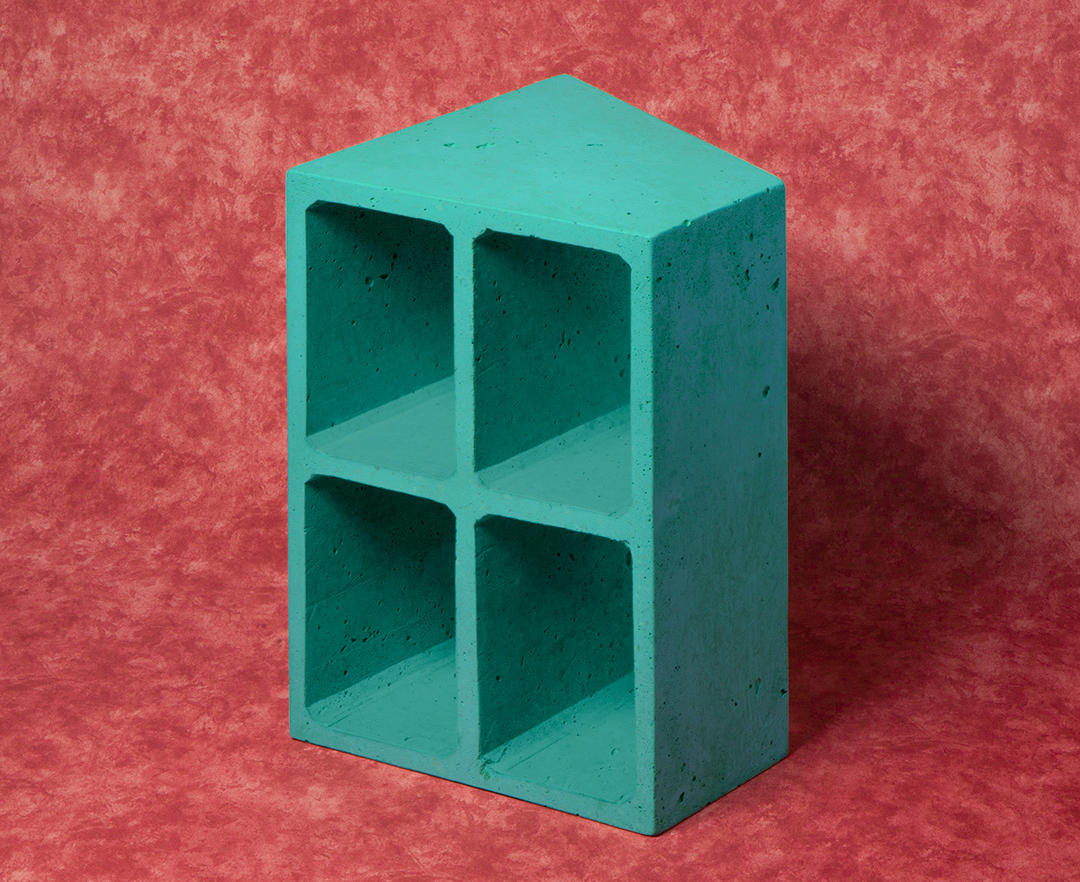
04.28.21
In Conversation
Marco Campardo and the Marta Gallery Founders On Obsessive YouTubing, Failed Projects, and the Importance of Craftsmanship in Design
Marco Campardo was born in Jesolo, a small town near Venice, and in the tradition of many Italian designers before him, from Gio Ponti to Bruno Munari, he has always possessed a restless, multidisciplinary spirit. In 2005, he co-founded the Venice-based graphic design studio Tankboys, where he created work for the Biennale and in collaboration with Memphis legend Nathalie du Pasquier, among others. With his former partner, Lorenzo Mason, he went on to found M-L-XL, a curatorial and design practice whose most iconic work clearly articulated Campardo’s interest in materiality and the subversion of industrial craft: Called Elle, the collection of chairs, shelves, and tables was based on a simple metal L-profile. Rather than being made from aluminum, the pieces were constructed with solid brass, transforming an ordinary element into something sophisticated and bespoke. That the pieces were coated in holographic car paint only served to heighten their appeal and emphasize the interplay between mass production and craftsmanship.
In 2020, however, Campardo founded his own studio, and it’s here that the designer has truly come into his own, fusing his interests in two-and three-dimensional design into a total vision, often working simultaneously on furniture, graphics, and environments for a single client. It’s also here that he’s made two of our favorite products: The first is a collection of tables made from reclaimed sheets of Alpi wood, their veneered layers glued together to form thick, structural blocks that are then chiseled around the perimeter as a way to clearly identify the hand of the maker. The second is a borosilicate glass toilet paper holder created for an exhibition at Marta in Los Angeles last year, curated by Marta’s founders — and Campardo’s old friends — Benjamin Critton and Heidi Korsavong: two names that will be familiar to longtime readers of Sight Unseen (Critton designed our first ever printed edition, Paper View!). Considering Campardo’s long friendship with the two — as well as the trio’s shared interest in a multidisciplinary approach — we decided to go Interview Magazine–style with this Q&A and allow the three room to riff on ideas about collaboration, identity, and digital representation in design. What follows is an edited and condensed version of their conversation. — JILL SINGER
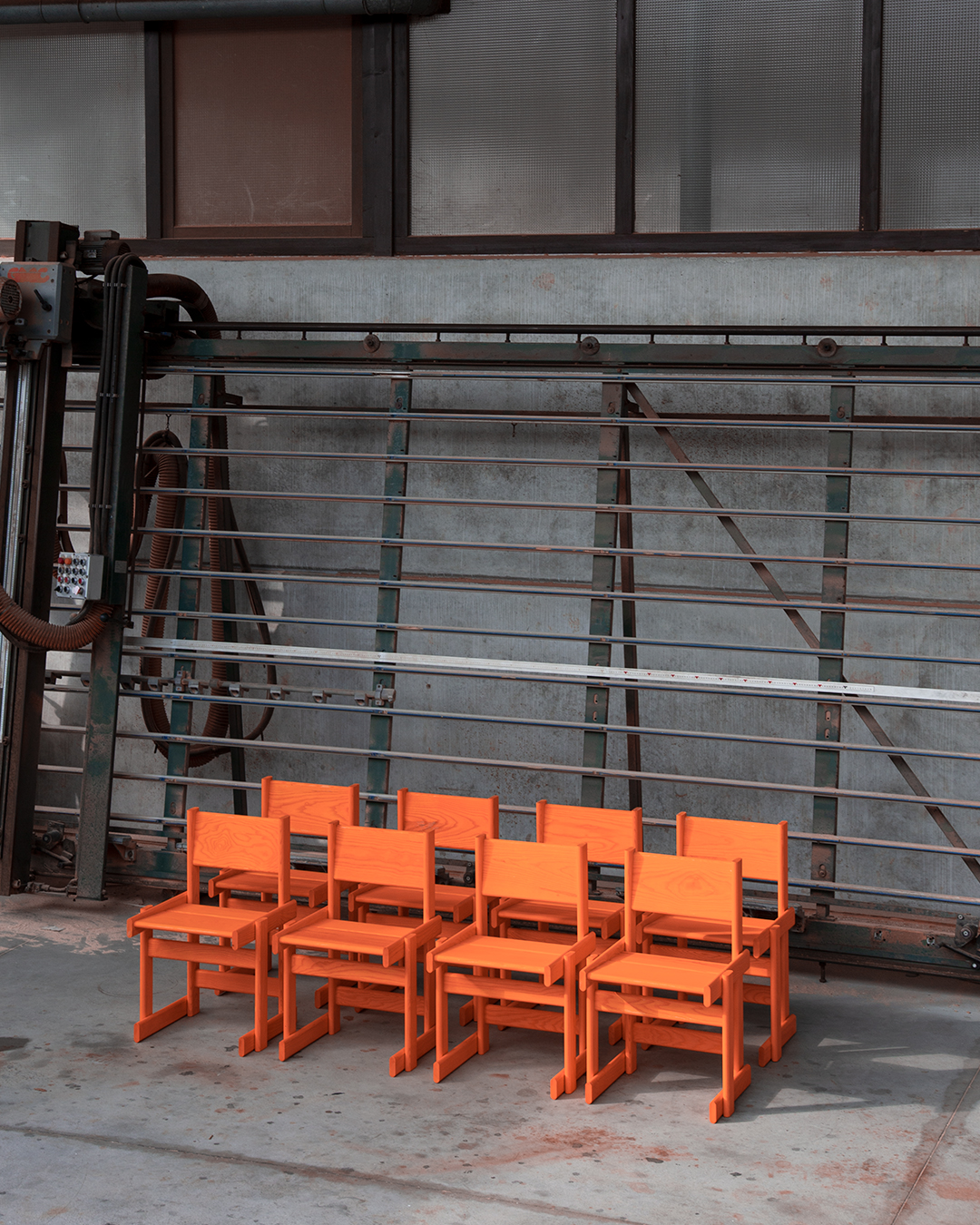
BULLNOSE chair by Marco Campardo
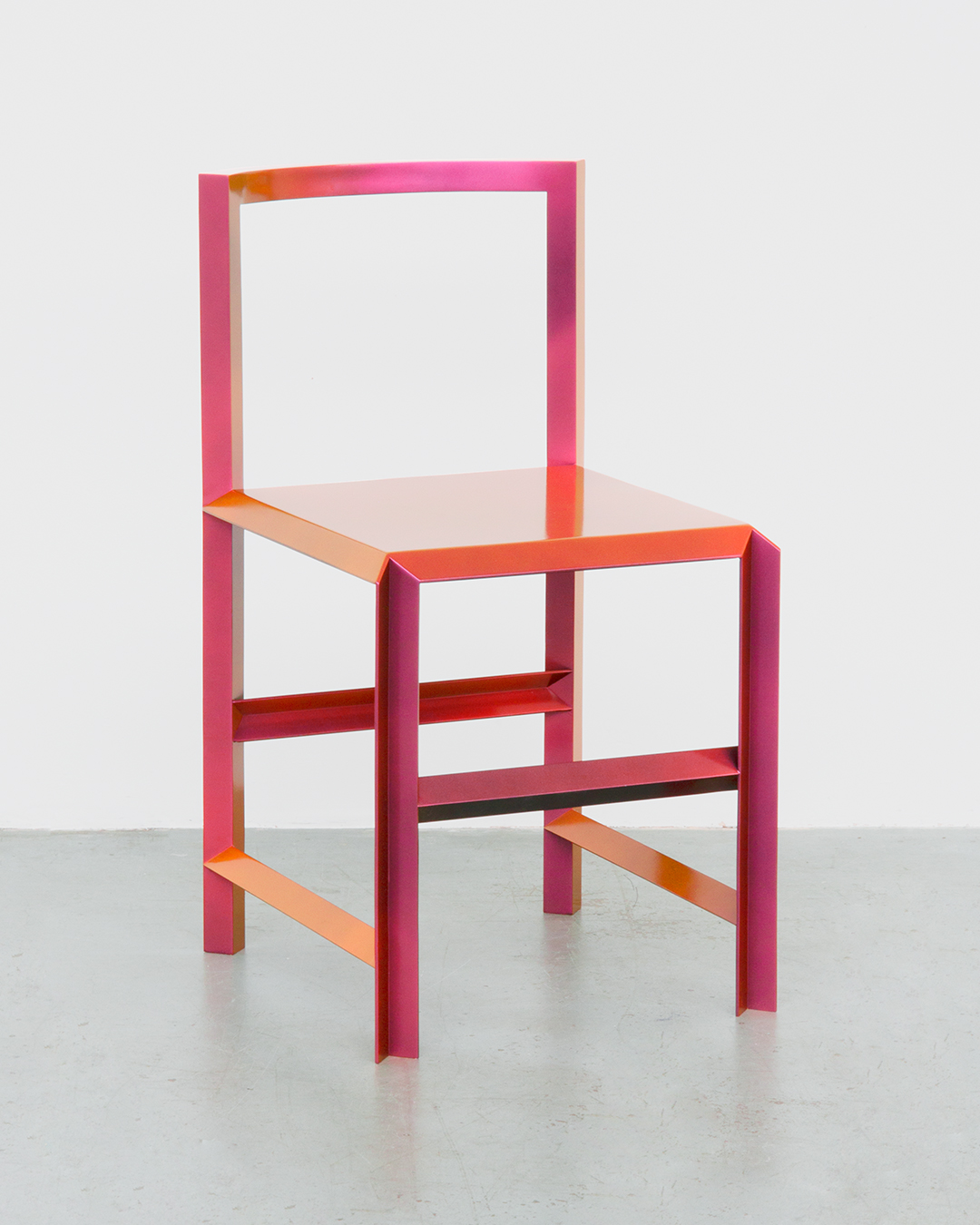
Elle by Marco Campardo
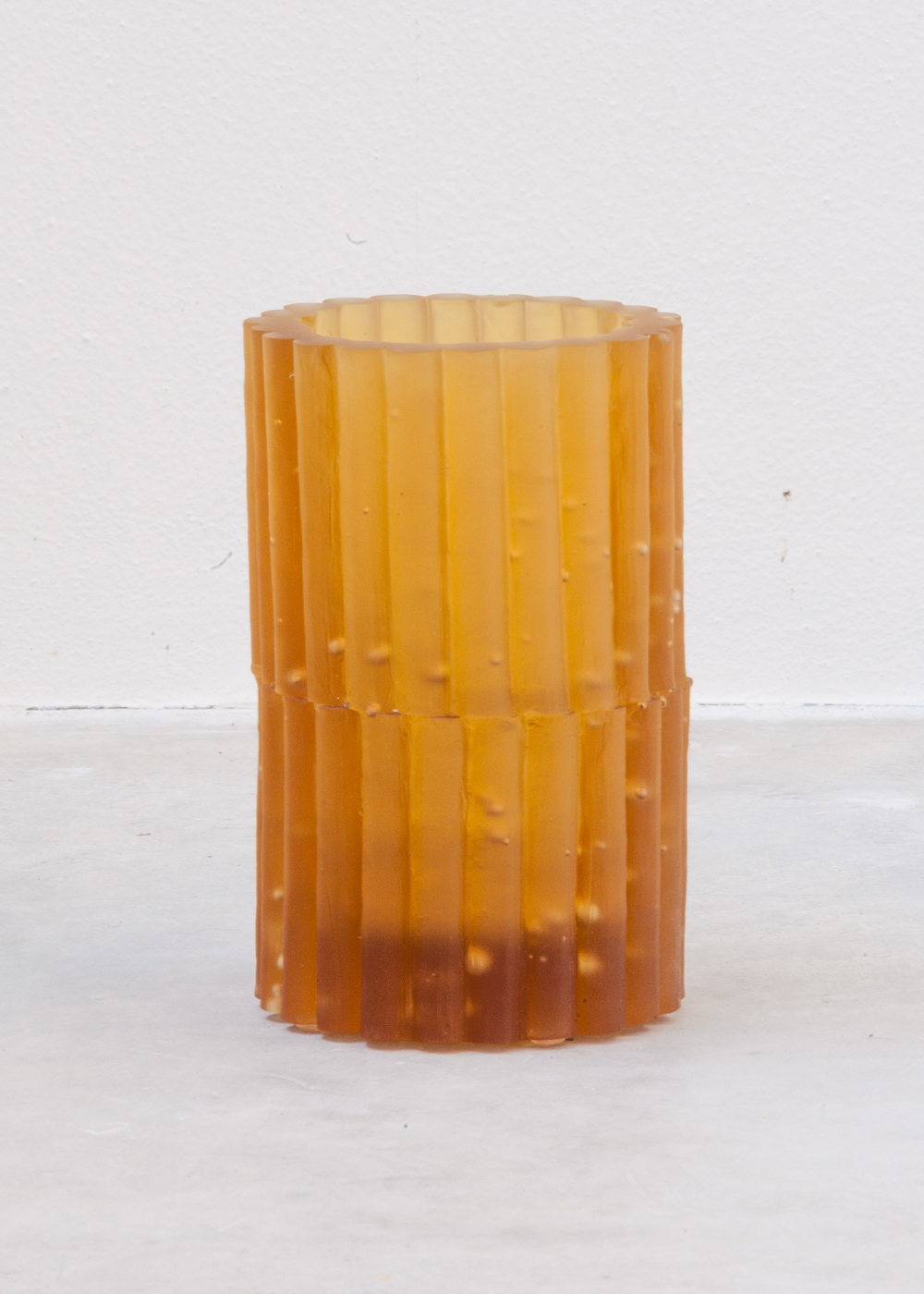
Vase by M-L-XL
BC: Hello, Marco. Quick introductions for the record. I’m Benjamin Critton, and this is Heidi Korsavong of Marta, and we are very happily introducing Marco Campardo of Marco Campardo Studio, who we’ve known in various ways since…
HK: 2014?
BC: Maybe even earlier, digitally.
HK: Let’s start with your background. Can you tell us about some of your earliest experiences that sparked an interest in design?
MC: I think it all begins during my childhood with my great craftsman dad. I have this memory of spending summers with him and my brother, Andrea, completely surrounded by wood. We were making everything from a mini 4Wd circuit to a treehouse.
There were no limits. He never said no, or this is not possible, or — even worse — this doesn’t make any sense. Now, he’s 78 years old. Always up to try something new, even though the risk of a failure is always around the corner. It’s thanks to these failures that we can make real progress. It’s impossible to push boundaries by risking nothing at all.
At university in Venice, I started to develop more formal training between different disciplines — graphic design, product design, and furniture design. It was very multidisciplinary. What’s interesting about having a degree is that you immediately understand that your training at university is just a small bite of an infinite medium.
Once you understand that it is just a bite, you have to walk this path of self-doubt. For me, it’s not easy to stay focused on just one thing, even though I spent 15 years doing graphic design, seven years acting as a publisher and three years as a creator. My nature is very curious.
BC: You mentioned your father. Were your parents creative people?
MC: No. My family is just a regular family. But it’s incredible how important it is to find someone who, instead of building walls in front of you, is opening doors without underestimating your dreams. My dad was exactly like that. It’s incredible how many times I still call him from London, asking for advice.
BC: Heidi’s dad is similar, he’s very handy. He’s an engineer, so he has all these skills. My dad — he could swing a hammer, but nothing more. He was an architect, but he worked with other craftsmen to achieve his vision. So, this idea of being able to pass down tactile knowledge is really amazing.
HK: This idea of solving by doing is a really interesting thing to pass down, too.
MC: Thinking with hands.
BC: Yeah, that’s a nice phrase for it. Do you hope to pass down that knowledge in a similar way? I mean, you teach.
MC: Yeah. I’m sure you’re familiar with The Craftsman by Richard Sennett. Great makers used to die keeping their secrets. So, for me, teaching and transferring information is a very important thing.
When I started to be more interested in product and furniture design, there was this feeling of, “No, this is a secret. I’m not going to explain to you how to do that.” Now I’m the opposite. Knowledge is progress.
BC: It’s very interesting in design. There are the people who don’t share anything and the people who are willing to share everything, and there are very few people in between. We found in New York, for example, people really held their cards close to their chest. But in LA, it’s been quite open and generous.
MC: Well, as long as you’re not registering any patent, what’s wrong with that?
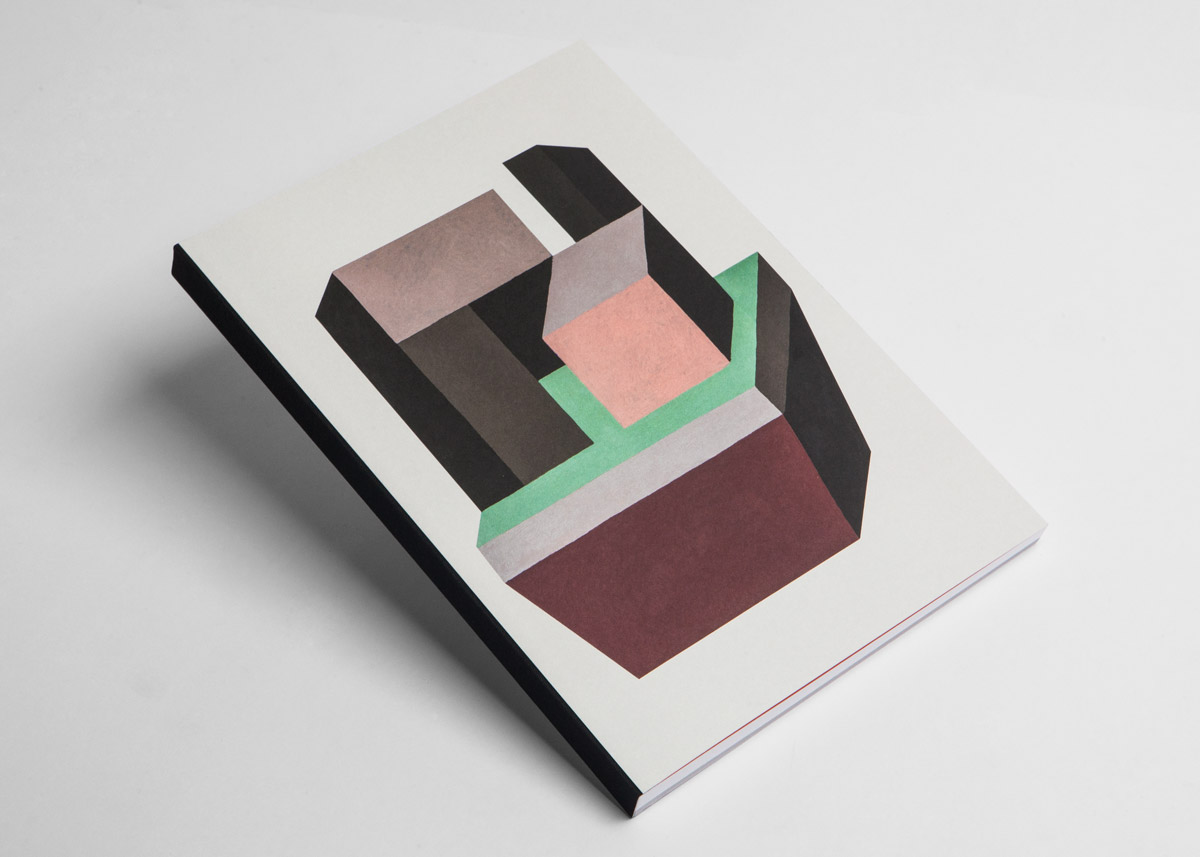
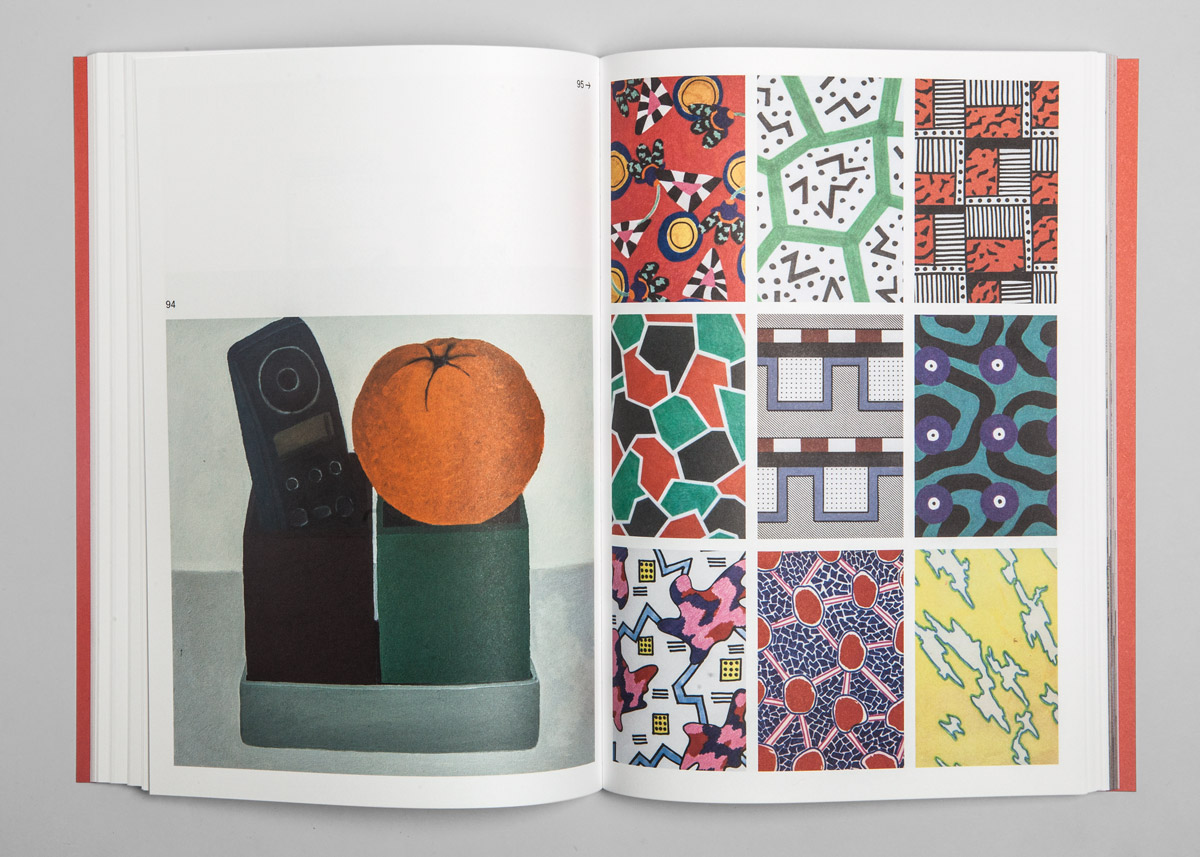
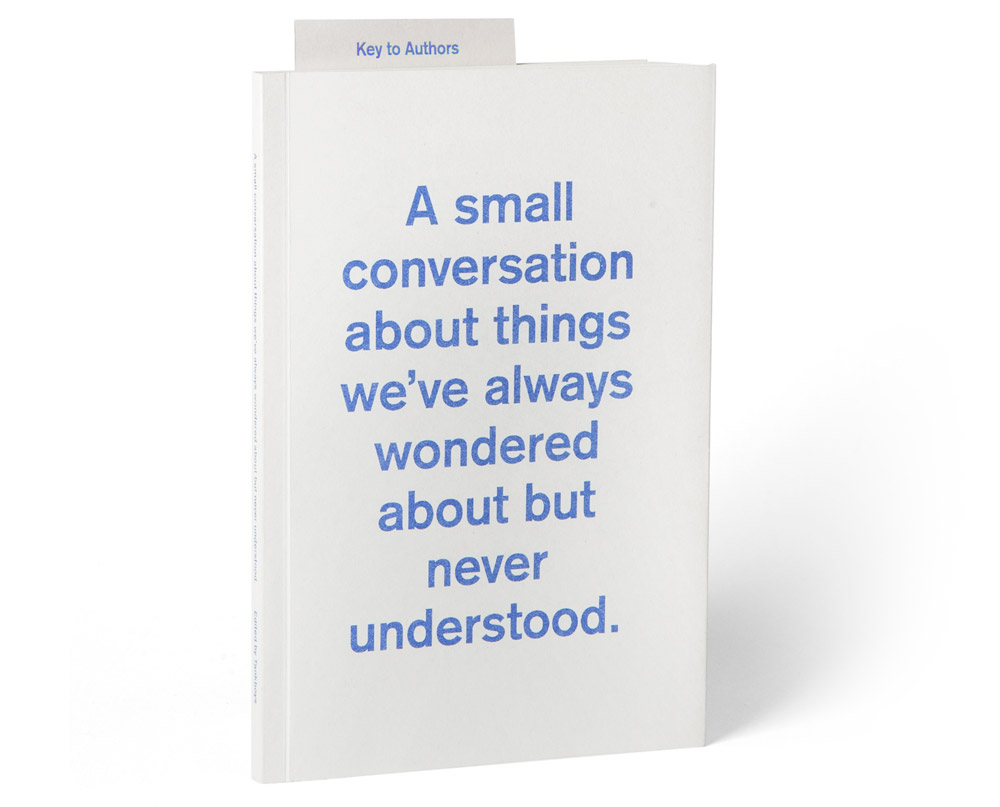
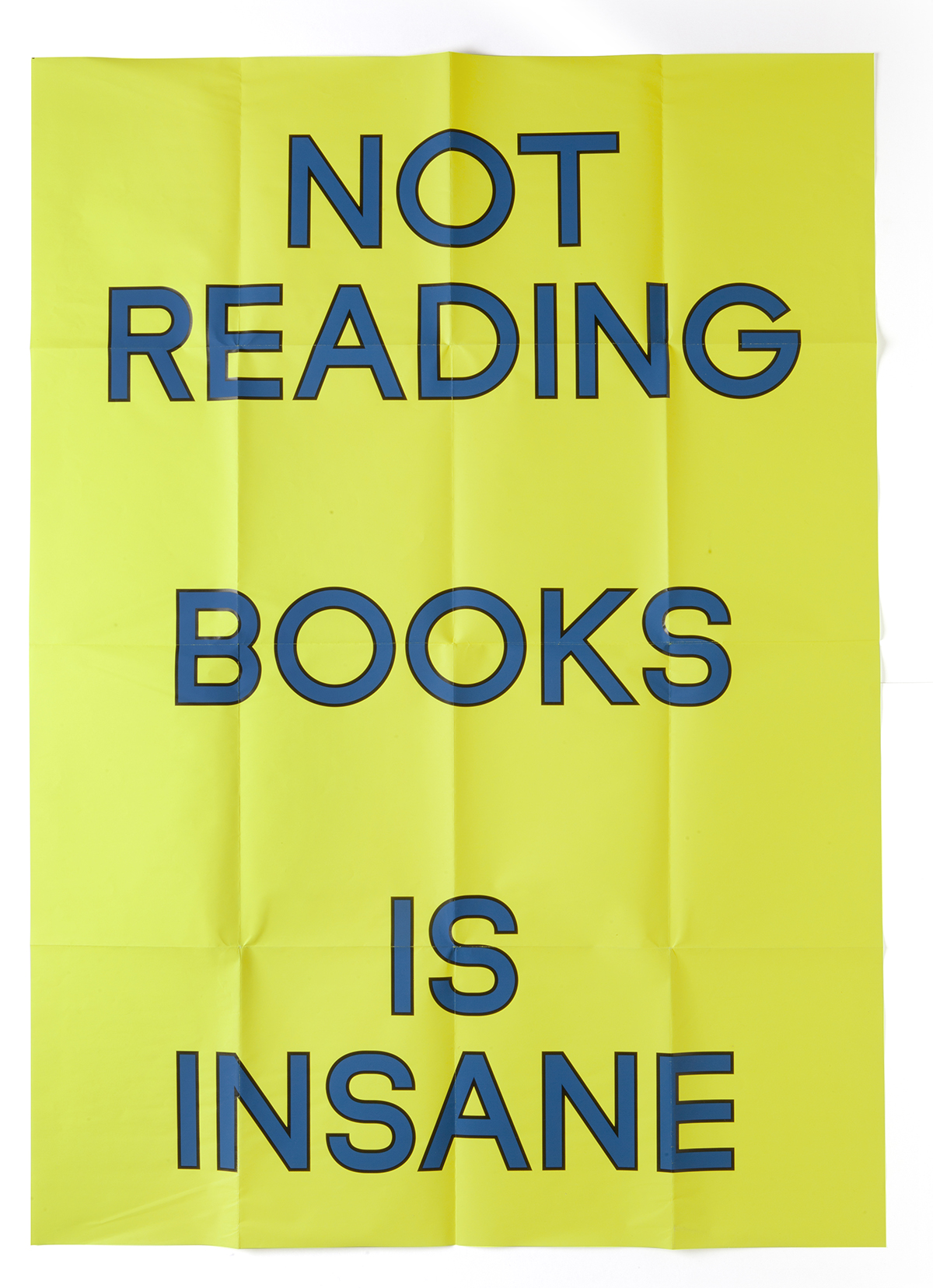
Tankboys
HK: Let’s talk a little bit about your studio progression. You did Tankboys and M-L-XL — both with your former partner, Lorenzo Mason — and then Marco Campardo Studio, but all along the way you were also pursuing endeavors like your publishing house, Automatic Books, and other happenings.
MC: I’ve always been interested in multidisciplinary approaches to design. This is an attitude I recognize in all of my references: Sottsass, Bruno Munari, Enzo Mari. They all approached design fluidly. As Gaetano Pesce used to say, design is liquid, and moving between publishing, exhibitions, working with industry and clients — my attitude is part of this heritage. A few years ago, I did realize that my attention had consciously started to move from 2D to 3D objects and environments in general, and I was interested in materiality and research that I could not always explore within the boundaries of commercially-oriented communication design.
BC: I feel like there is a particularly Italian lineage to that approach. But since the ’60s, it feels like there’s been a shift towards specialization.
MC: Doing different things doesn’t mean that you are not specialized, though. If you spend 15 years working as a graphic designer, and then you spend 10 years working as a product designer, and then you spend 10 years doing photography, at the end, you would be, like…
BC: A specialist in all three.
MC: Yeah. Do you like to cook?
HK: I do.
BC: I’m not good, so I don’t like to do it.
MC: But let’s say that, from today, you will start to cook every day.
BC: I would be great at it if I chose to…yes, I know what you mean. Yes.
MC: It’s a matter of obsession sometimes. When you dedicate yourself to something, in the end, you become a specialist in that. Sometimes, when I’m speaking with people about a specific material or a process, they look at me like, ‘How do you know this kind of stuff?’ I just spend nights on YouTube, man.
BC: Let’s talk about your work with Nathalie Du Pasquier. I know you did some record covers with her for Morphine Records, and some exhibition catalogs. How did you meet?
MC: My partner, Rujana, was doing an interview for a magazine one day in Milan, and she introduced Nathalie to me. We became instant friends. I was at a moment in my life where I was looking for something different from my experience as a graphic designer.
The first time I visited Nathalie and George Sowden, her partner, in their studio, I was completely swept up. While I was going around the studio, I started to have — in a positive way – a big headache. It was full of projections of their existence. I saw this environment full of books, objects, painting, furniture, and I thought, ‘This is a total manifestation of creativity.’
Our first collaboration was with Automatic Books. After that, we made an LP, and I also made the catalogue for Kunsthalle Wien during her first show in a museum, which was curated by Luca Lo Pinto.
As a multidisciplinary designer, I run my studio like they do, in different ways based on the processes that I’m currently interested in. I really like this Italian Modernist idea of a total design. An example is the recent project that I developed for the Museum of Contemporary Art in Rome, under the direction of Luca Lo Pinto. I developed the identity, the furniture, and the displays of the museum. So, basically, a total design.
BC: Actually, one of our questions was going to be do you still practice graphic design at all? It sounds like yes, but oftentimes the goal is to incorporate it with other parts of your practice.
MC: Yeah.
BC: Are you responsible for the graphic design of your own studio?
MC: Yes.
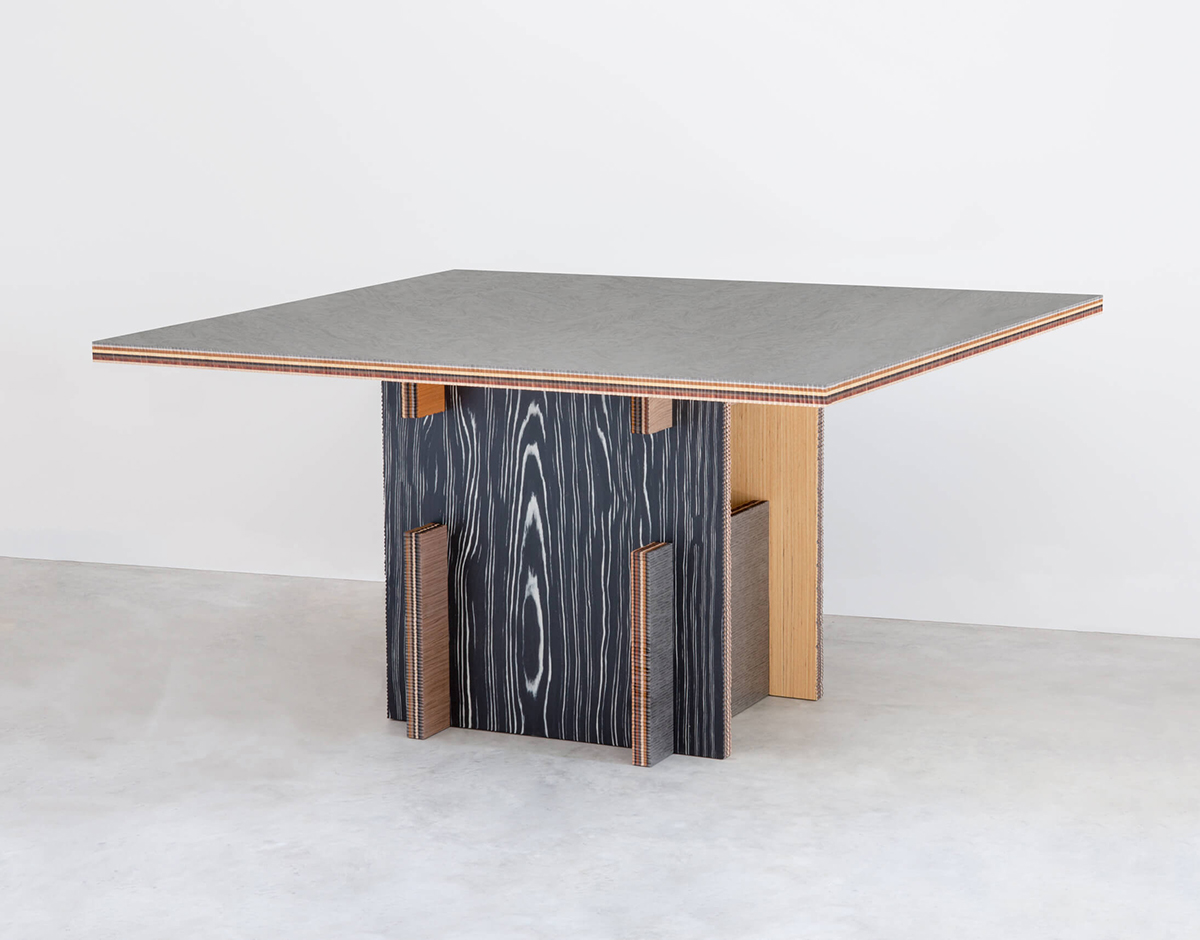
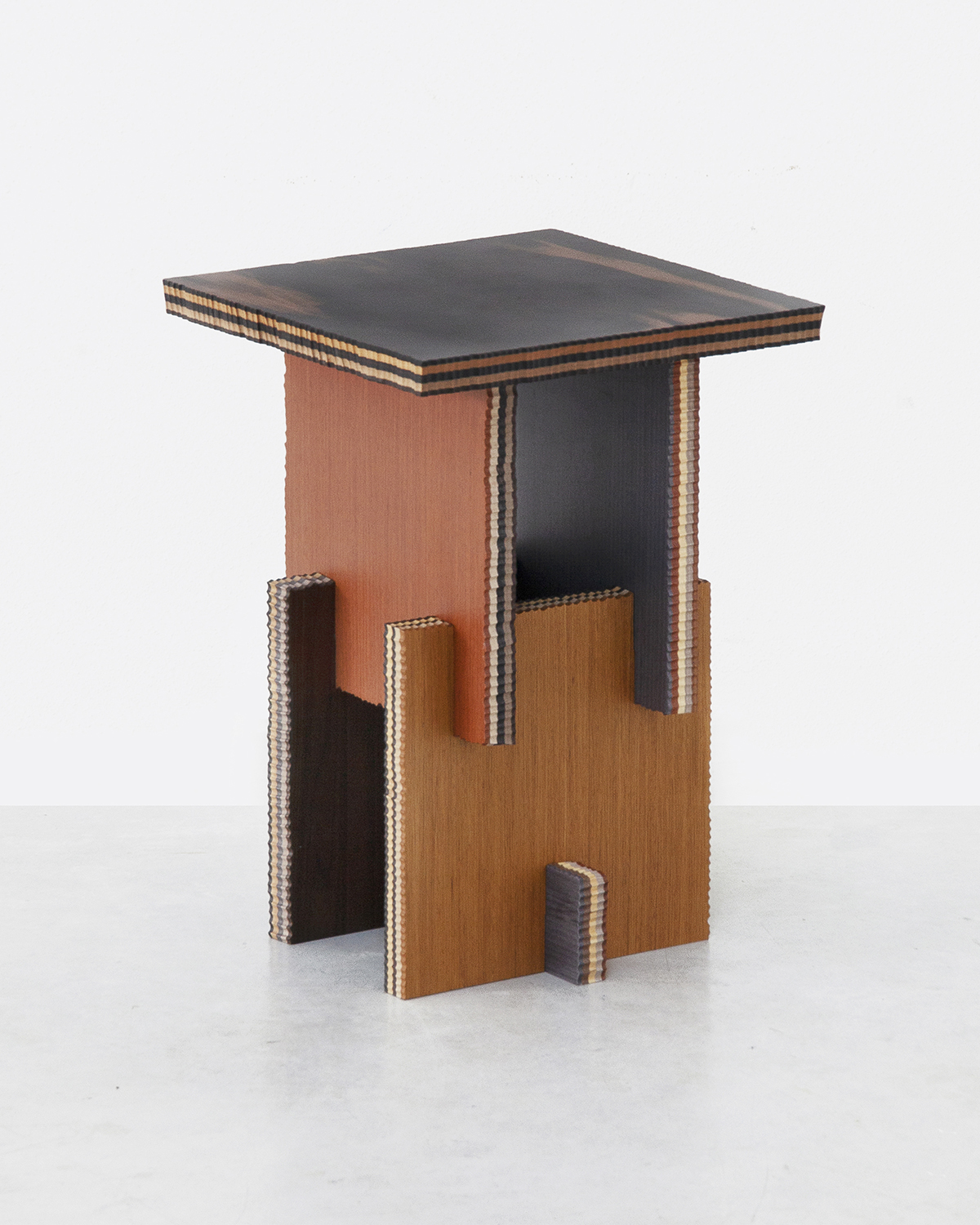
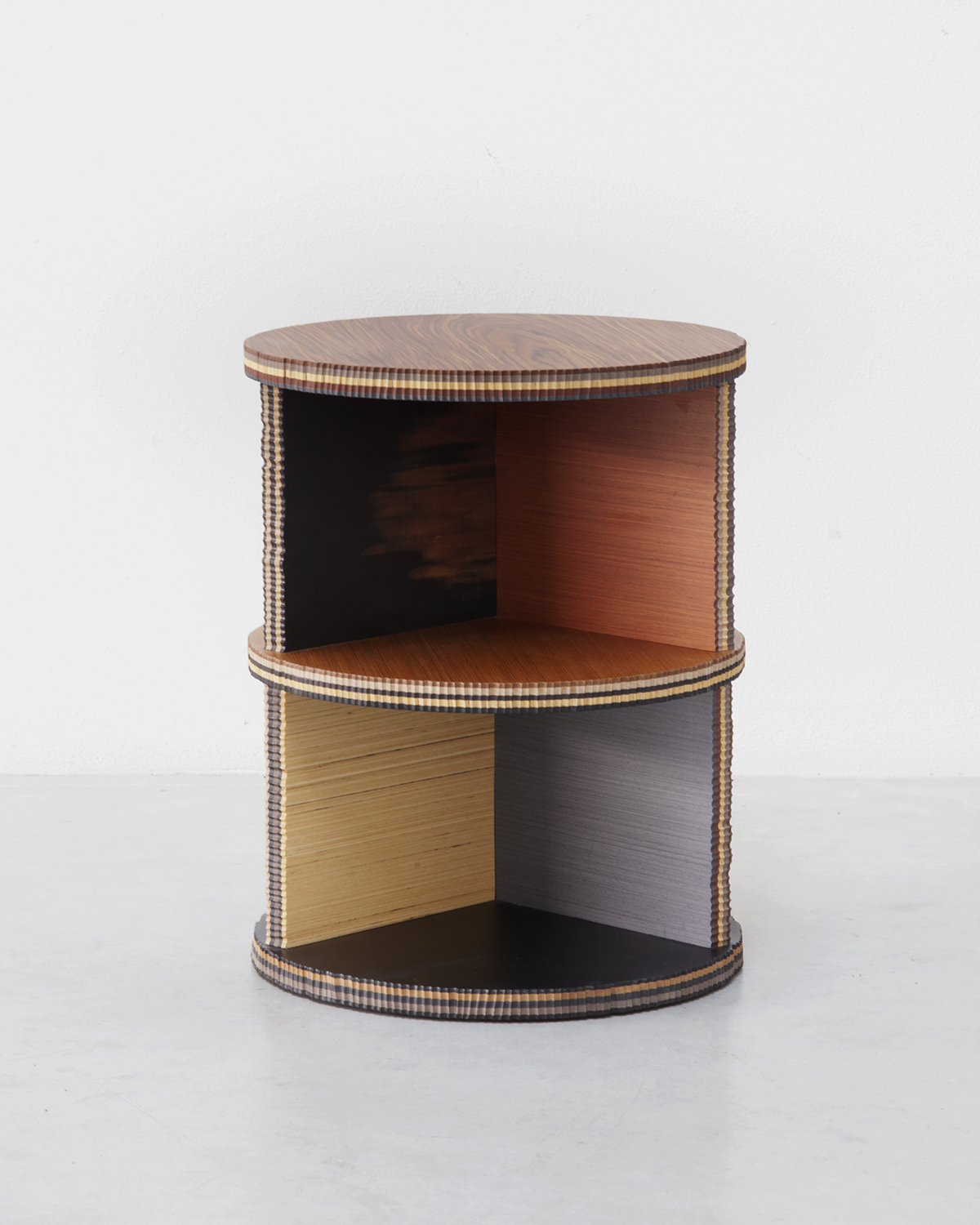
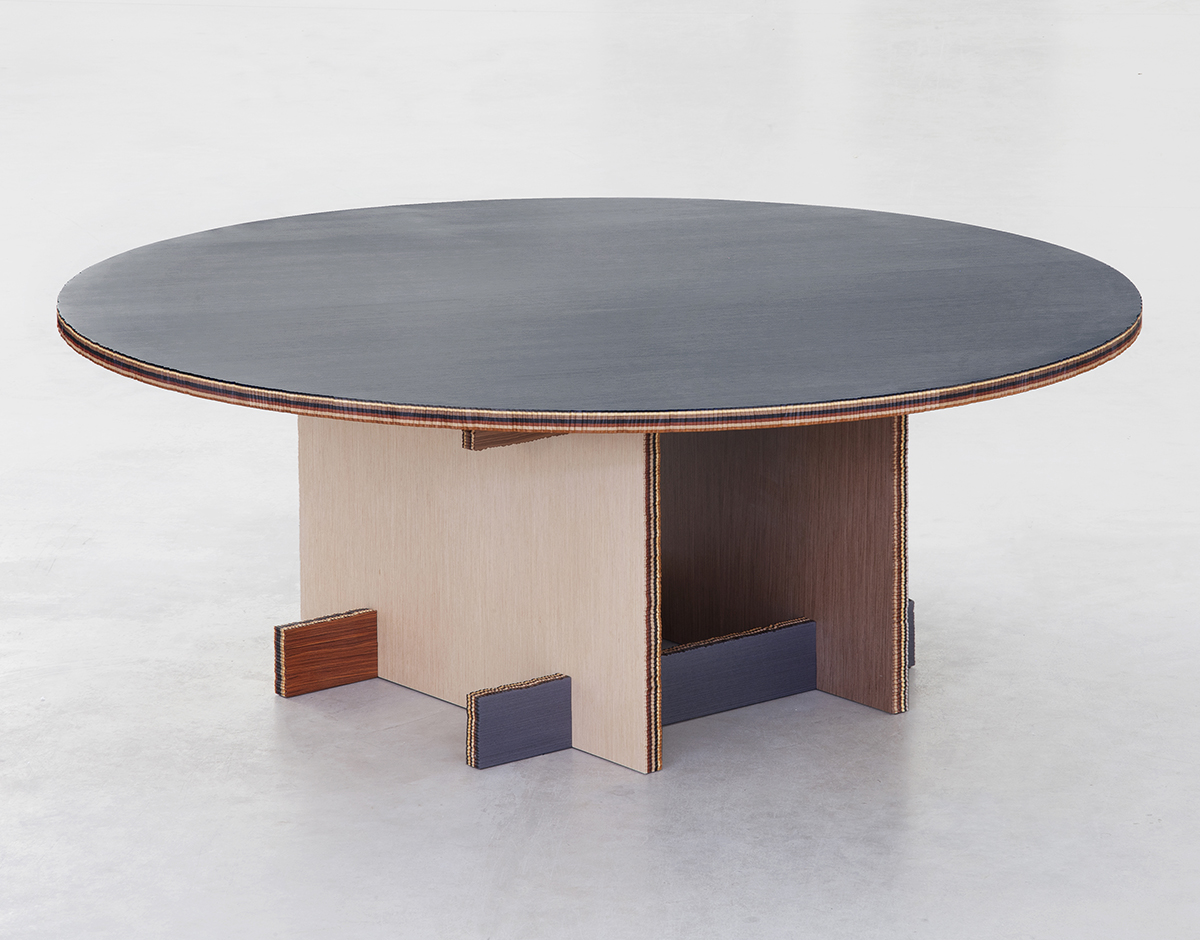 George tables by Marco Campardo for Seeds Gallery
George tables by Marco Campardo for Seeds Gallery
BC: When you’re tasked with representing your own work, it becomes very meta, you have to decide how to give voice to your own output. What kinds of things go through your head when you’re thinking about representing your own work?
MC: My studio is very small. I work with an assistant, but basically, I’m doing everything by myself. I’m taking photos of my objects and creating the identity of my studio. I have specific schemes and rules to make the photos and about how I like to show my objects. But it’s like Sister Corita used to say: It’s difficult to do and to analyze at the same time. I’m not able to publish everything I’m doing because I’m struggling to make photos because I made the photo shoot, and then I spent one month thinking about the right way to show that object. So, sometimes I’m not happy with it and decide to remake the photoshoot! When you work for yourself, you’re thinking 10 times more about what you’re showing.
BC: Yeah, we toil so much trying to come up with the best or most elegant way to present something, and often, like you’re saying, what that means is we just end up not presenting it. There’s a great David Byrne quote from around the time of Stop Making Sense. He was wearing the same outfit every day, and an interviewer asked him why, and he was like, well, it’s just so that I can conserve energy to think about the other important things.
MC: You see? Anyway, this was just a long way to answer, you know, the fact that when you think about how to represent yourself, it’s more complicated.
BC: What do you call yourself these days? Do you just call yourself a designer?
MC: In Italy, they call you artista. This is very funny, I don’t know if I can explain it. When you work with companies — manufacturers, carpenters, woodworkers, all these people who build things — if they’re not able to understand who you are there are two options: architetto, architect, or artista. So, even though you are a mathematician who is working with aluminum, CNC cutting, everything is super sharp, super amazing, they will say “Artista, come here. Have some milk.”
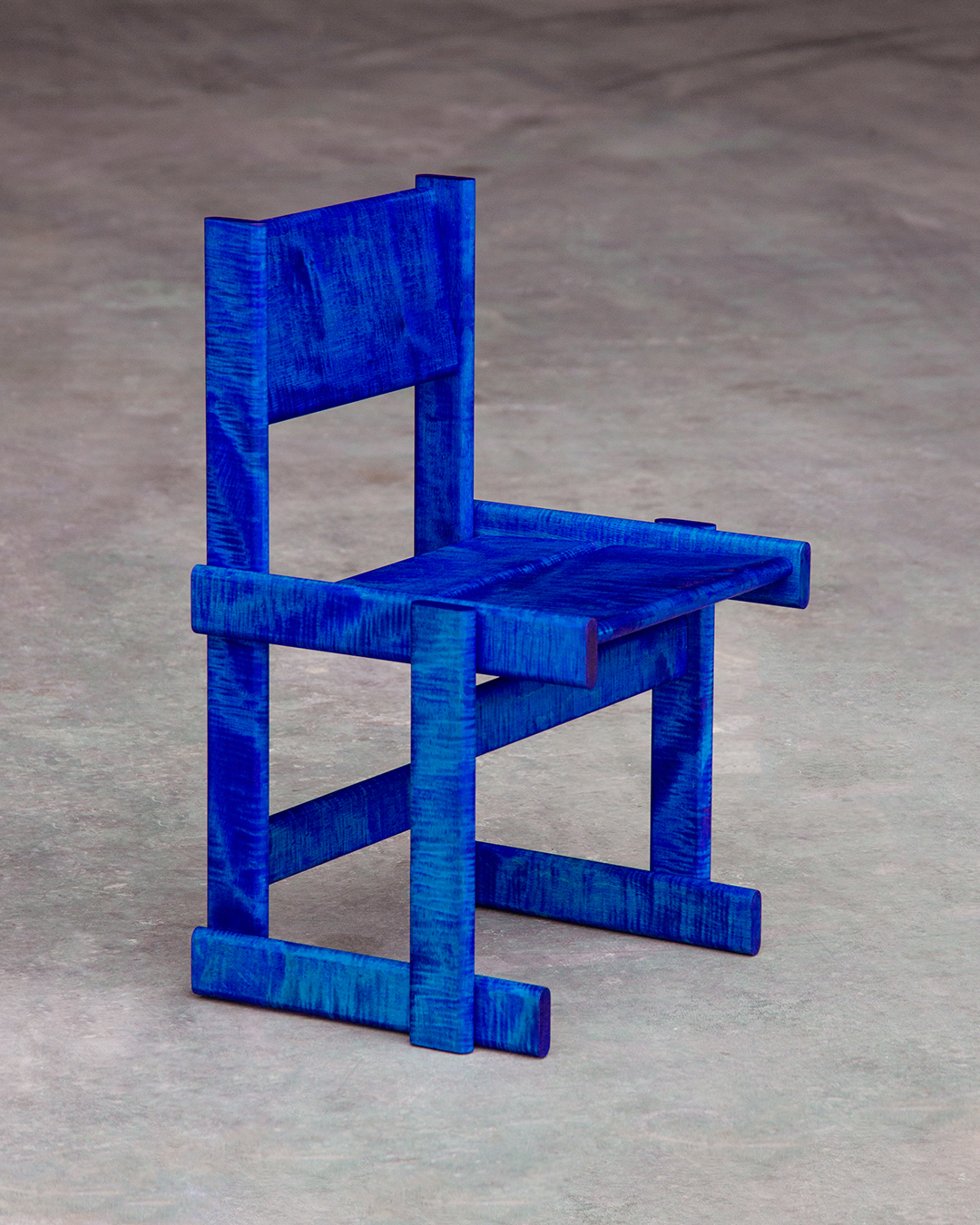
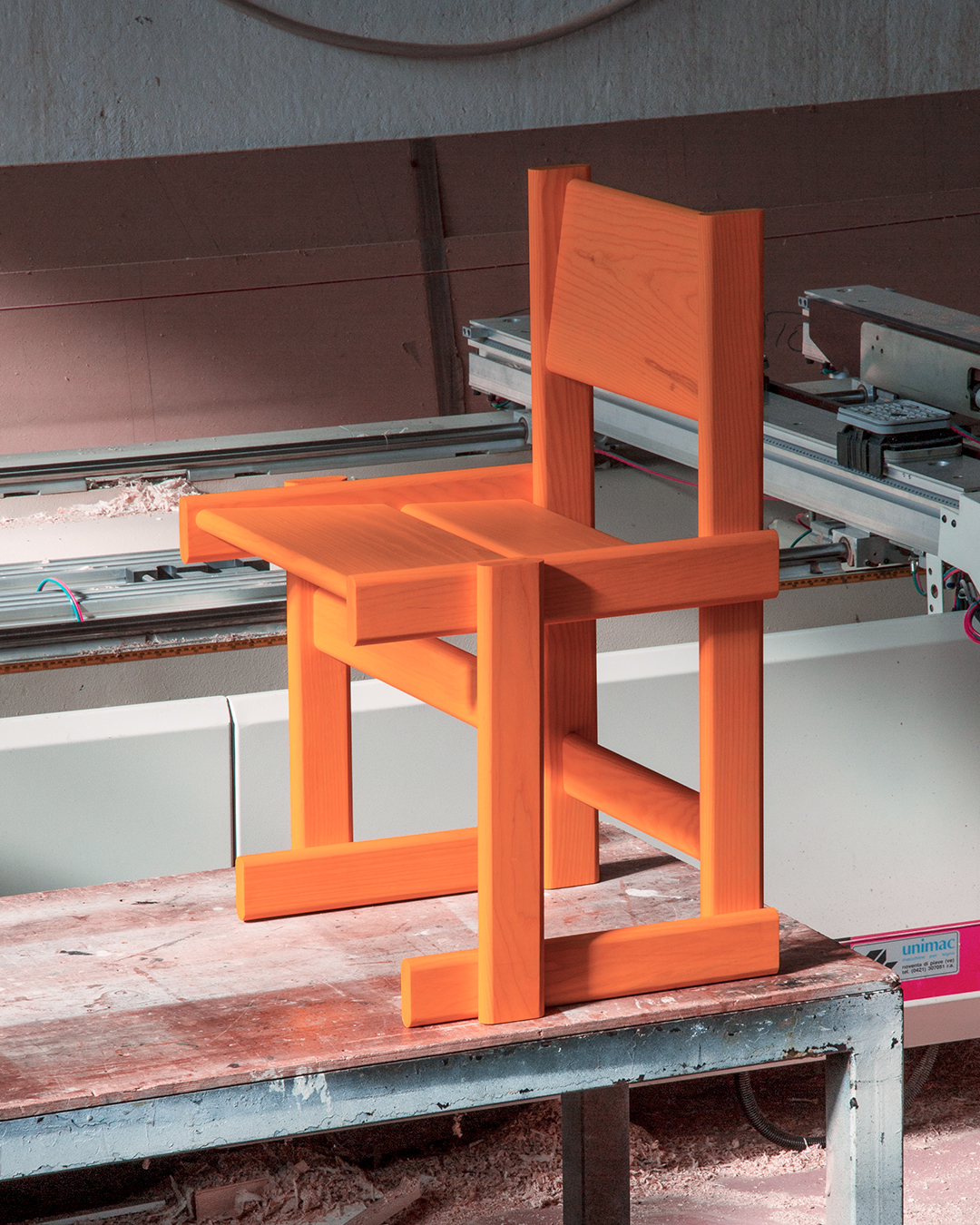
BULLNOSE chair by Marco Campardo
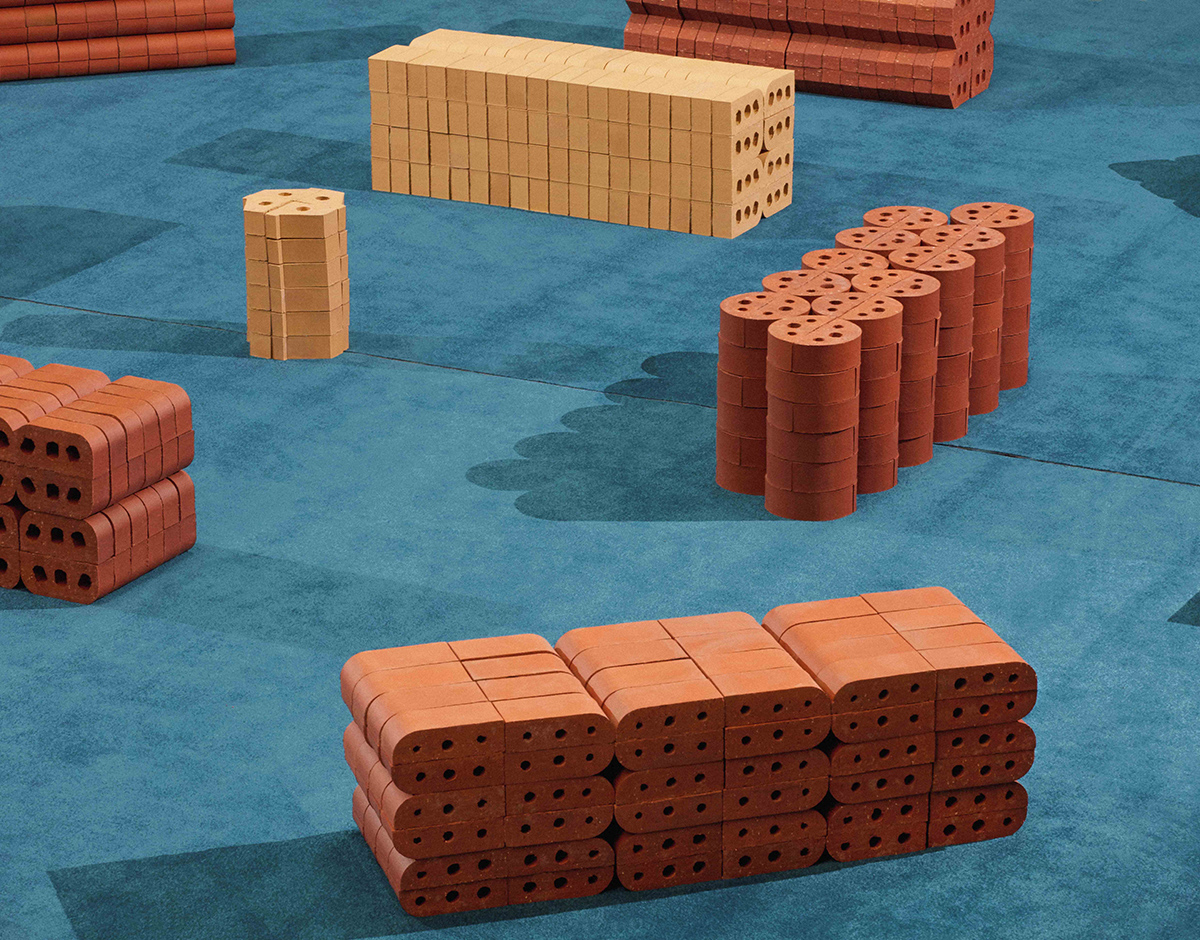
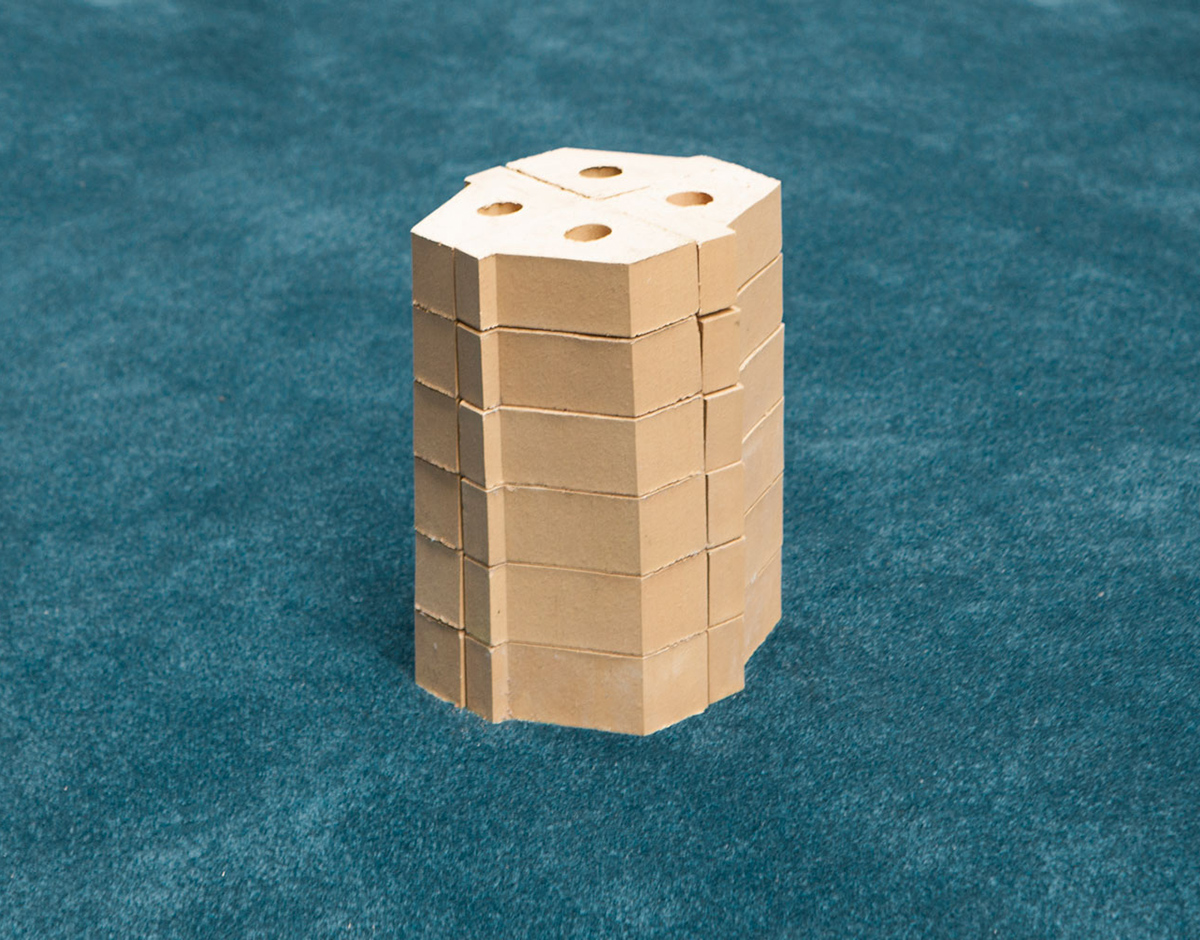
Heavy Formal Exercise, an installation by M-L-XL at the Tate Modern
HK: Let’s talk about your process. How do you begin to work? Do you find a material that you like to work with and listen to it, or do you work more intuitively and conceptually?
MC: In general, I start from the material, and I try to see how to inform the final shape with a specific process. I’m not super conceptual, and that’s very new for me, because with graphic design, I was pretty conceptual. Sometimes the result is a conversation between my thoughts and a specialist. I think the big difference between the designer and the specialist is that the specialist is concentrated on making the perfect chair with four legs, and the designer is wondering if the legs for a chair are necessary. Through this different knowledge, you can really create something special. But there will always be this fight between ‘we need four legs,’ and ‘do we need legs?’ Maybe we can find a way to have, like, a floating chair?
BC: Well, and your BULLNOSE chair has two legs, I suppose, in a way.
MC: Yes. I think the best approach to design is to find a way to dedicate more time to developing new materials and less time to shapes, because shapes are… it’s very hard nowadays to find new shapes.
BC: How much of your output is dependent upon your manufacturing partners, or these specialists as you call them?
MC: I used to spend a lot of time drawing, but most of the time, it’s a matter of me trying with my hands to work with different materials. And then, if I need someone to, say, weld brass, I have a great supplier in Italy that is welding and brazing brass eight hours per day. For the exhibition I’m designing in Rome, I will personally make the objects because the material I’m using — an infinitely recyclable plastic — is pretty new, and I’m still trying to understand how the material reacts. When you do speculation and experiments with design — once you find your supplier, you just pray that he’s not going to change what you had in mind.
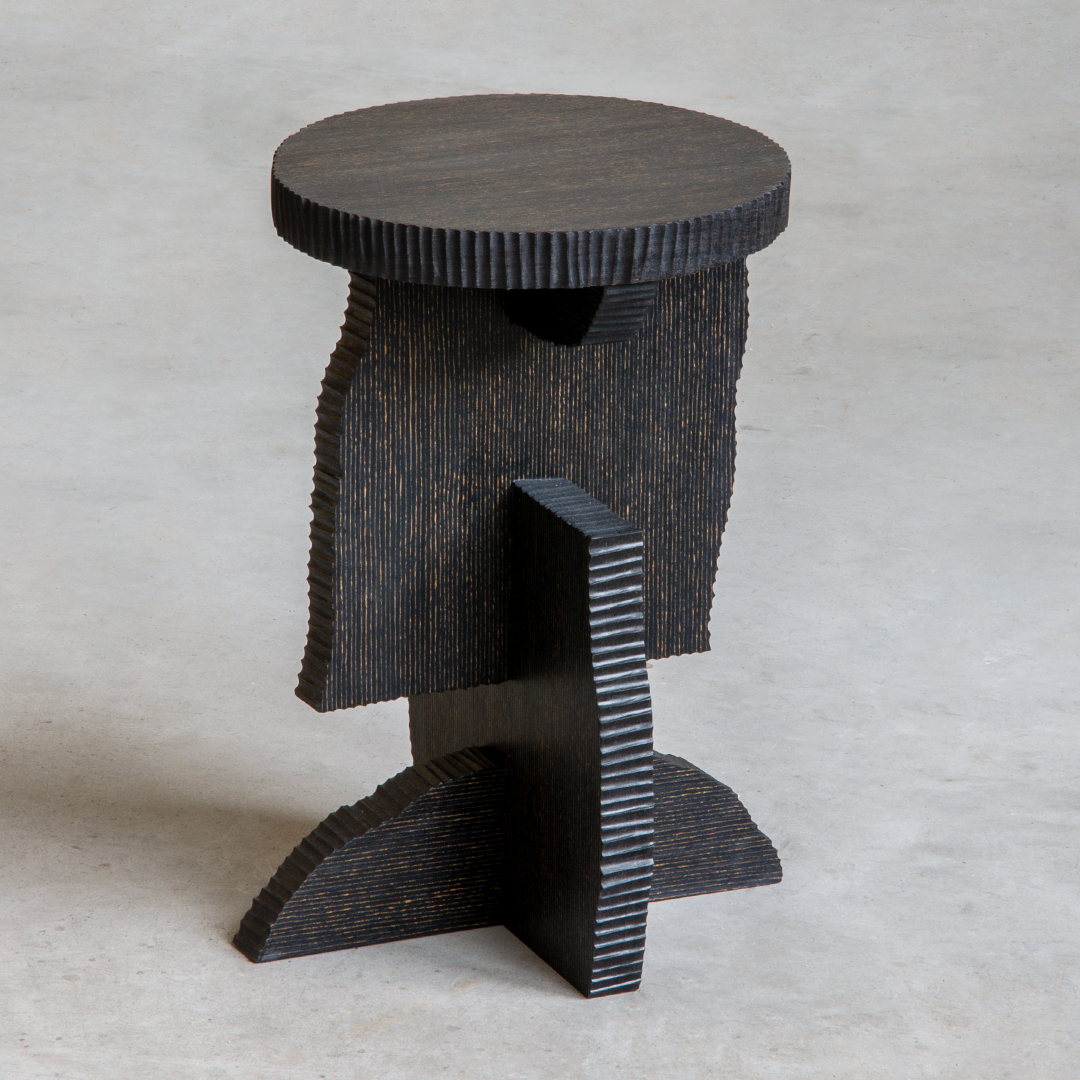
George table
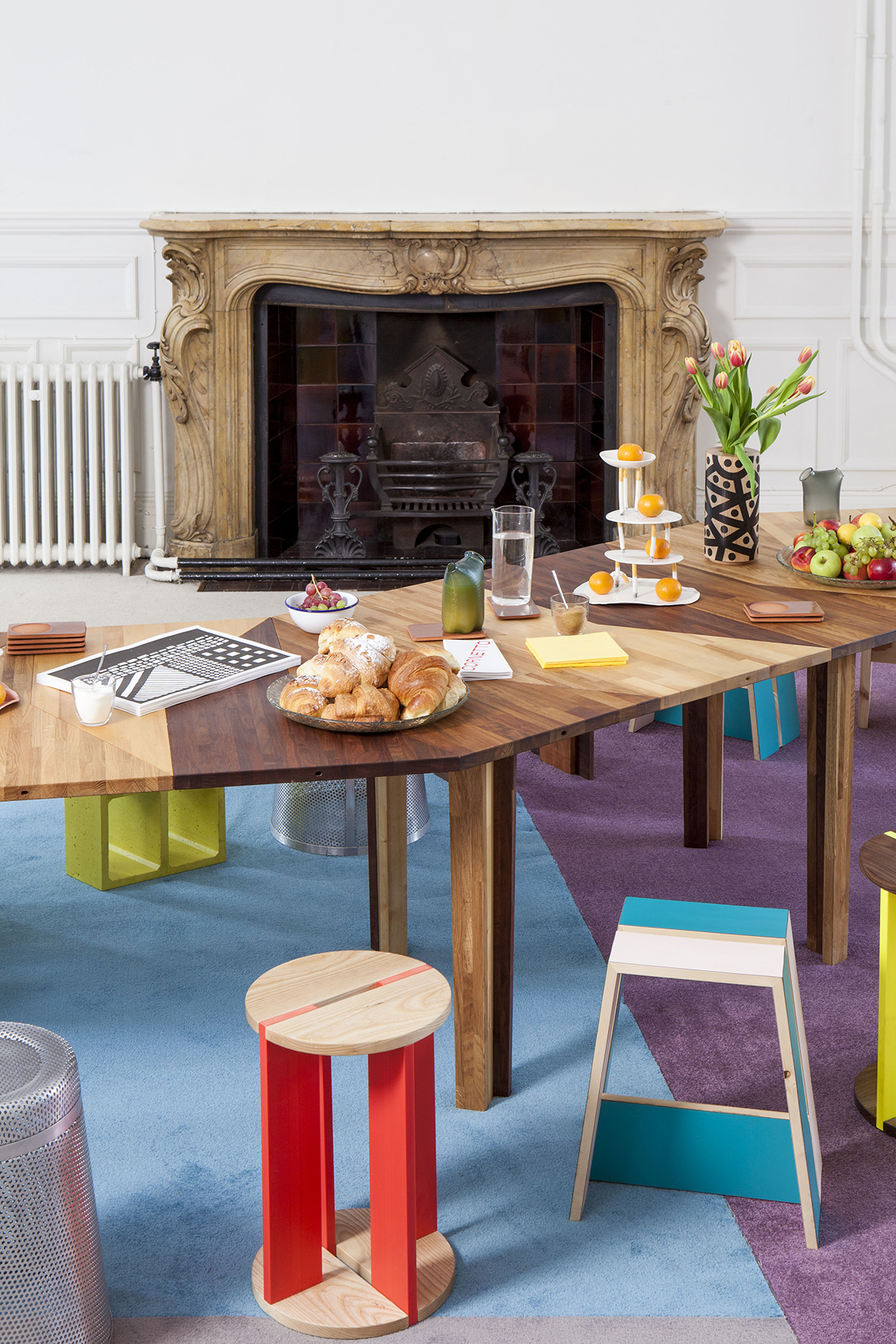
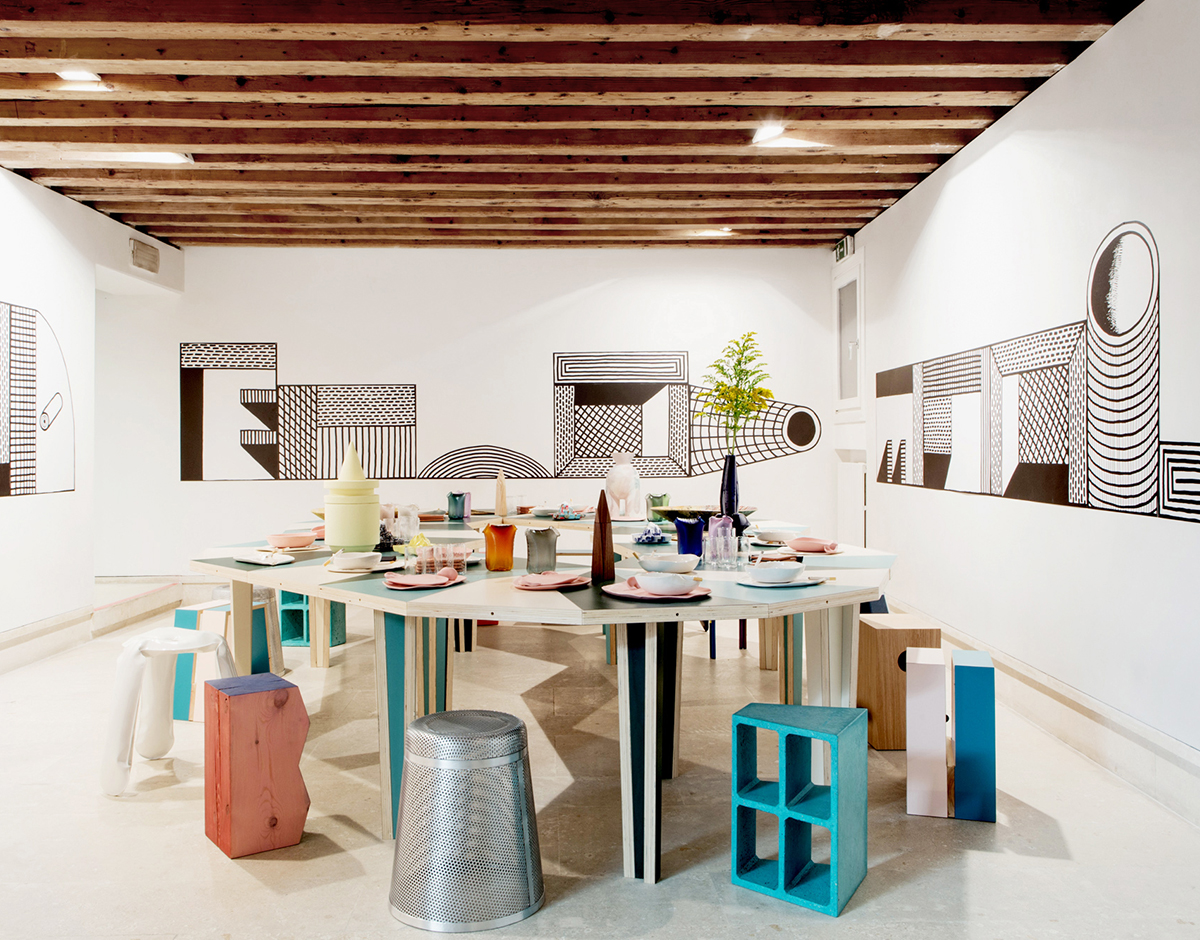
The Breakfast Pavilion by M-L-XL
BC: Has a project of yours ever completely failed?
MC: Yes. In 2018, I was invited to take part in this exhibition curated by Laura Houseley and James Shaw. I was supposed to present a recycled plastic stool. In general, I’m obsessed with finding new ways to produce things without achieving crazy prices. You know, in design, it’s very easy to do, like, a table for 4,000 pounds, or even 20 thousand pounds. To try to do, without industry, that table for 500 pounds — it’s completely different. So, for this I was going to use a vacuum forming process. I found this company in the UK, and they told me for the entire summer this project is amazing. Don’t worry. No problem. Everything is fine. One week before the show, I arrived there, and instead of using the process that we agreed on four months before, to save money, they were using another system that fails all the time.
After that, I changed course on the project. After a year or so, I found a company that was able to do the stools, but what I realized is that my dream of vacuum forming the stool was, like, with prosciutto negli occhi. I wasn’t able to see the real problem, which is that to produce the recycled plastic boards, you need to spend a lot of energy and use a type of equipment that makes the final board expensive like marble. So, I just abandoned it, but it was great because I learned a lot of things, including the fact that you might pay attention to your supplier better next time.
BC: Or, as sort of silly as it sounds, making sure to do that visit really early. Like that one annoying visit where you’re like, I just have to do this car drive three hours to…
MC: You camp. You camp there. You stay there until it’s done, man.
HK: You’ve mentioned figures who have influenced your work, like Enzo Mari and Gaetano Pesce. Which of your contemporary peers are you admiring or paying attention to?
MC: I’m very close to Attua Aparicio, she’s a ceramic maker, she’s great, and Jochen Holz. Lorenzo Vitturi is a very close friend. I used to work with him, helping him with books and banners and carpets for his own exhibitions. He’s a friend and mentor somehow. We used to spend hours talking about existence. I’m also thinking about Omnigroup, Leonardo Azzolini and Simon Mager. They’re a duo based in Switzerland, and with the MACRO project, I decided to use a typeface that they designed.
BC: I think that’s super nice, that you’re answering with people who you have sort of a symbiotic relationship with. I wanted to talk a little bit more about identity. You’re an Italian designer. You’re living in London. When we first met in 2014, you seemed really interested in Italian design and prideful of being in Venice where, you know, obviously, the architecture Biennale happens there, but it’s not thought of in the same way as Milan, as a destination for design. You seemed excited to be planting a flag in Venice. So, I’m curious, do you think you’ll stay in London for a while? Is being Italian in this profession really important to you?
MC: I came to London for love. My partner was doing a PhD. It was radically different from the lifestyle of Venice. But you know, even though we are in the middle of the COVID-19 crisis, and not benefitting from what the city can offer, I’m still enjoying being part of this great city. At the same time, my origins are Italian, and that means a lot to me. In a certain way, in relation to my practice, I feel more connected to Italy. And in terms of production, it seems that everything that I have in mind, in Italy, is possible.
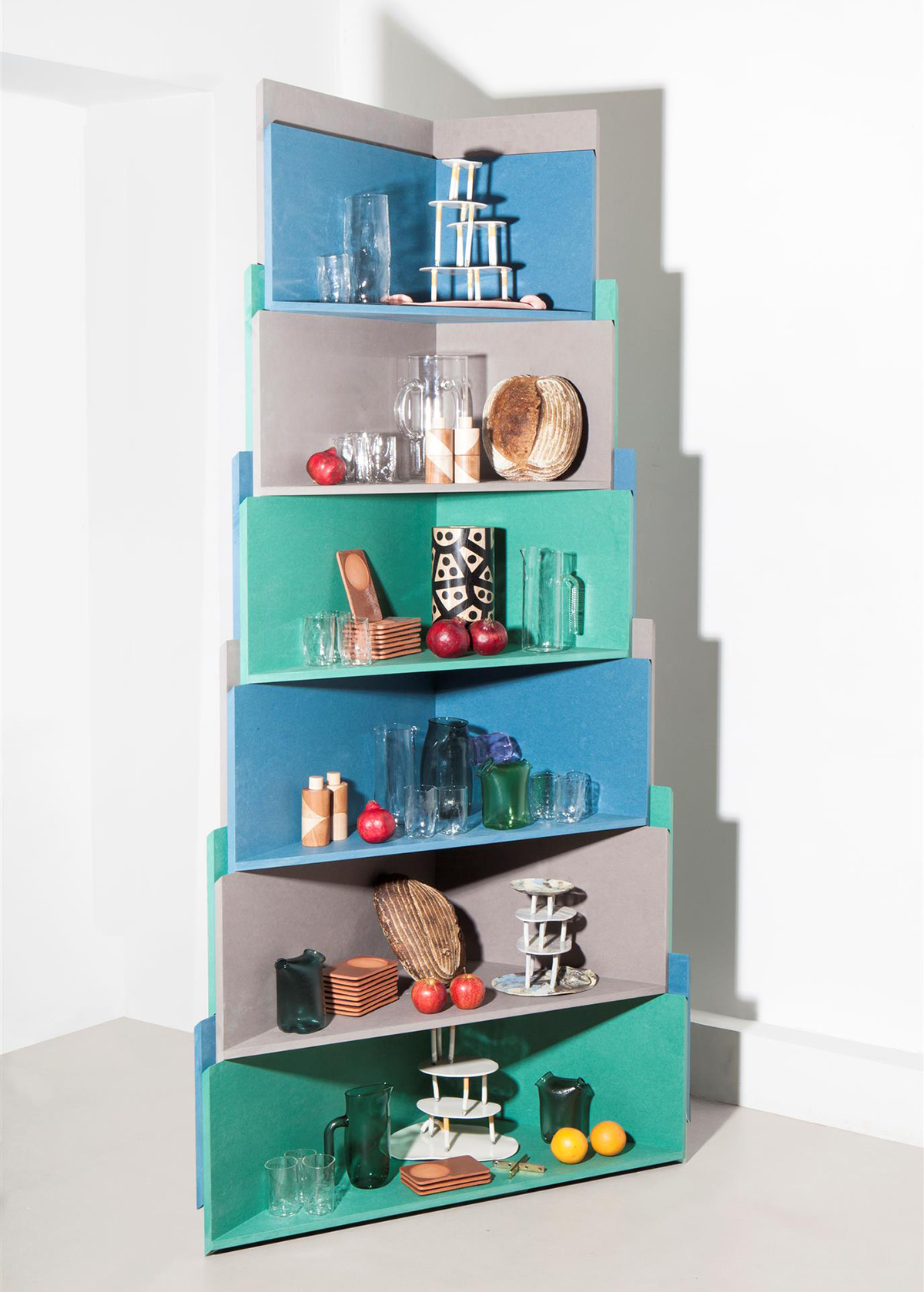
M-L-XL
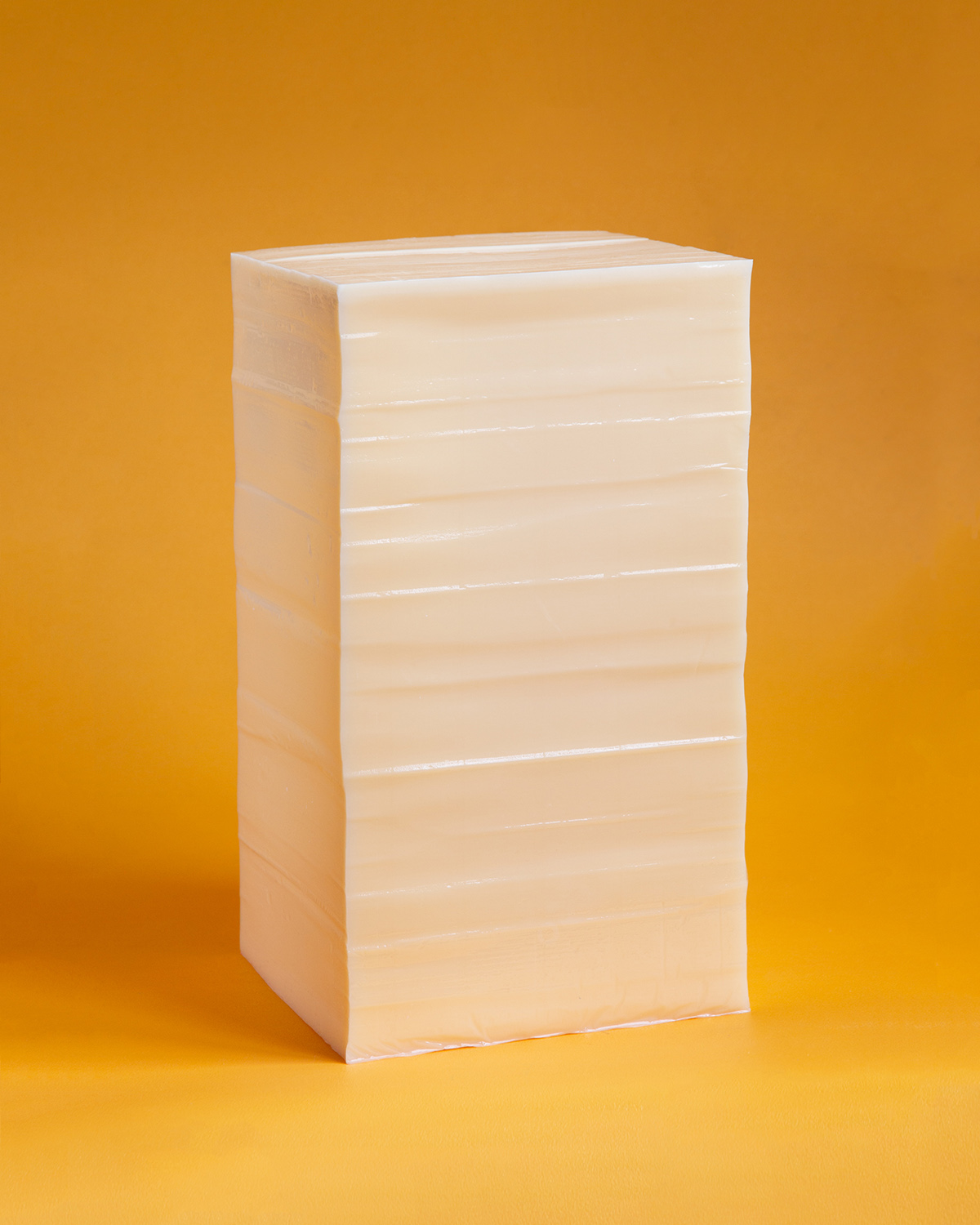
Butter Stool by Marco Campardo
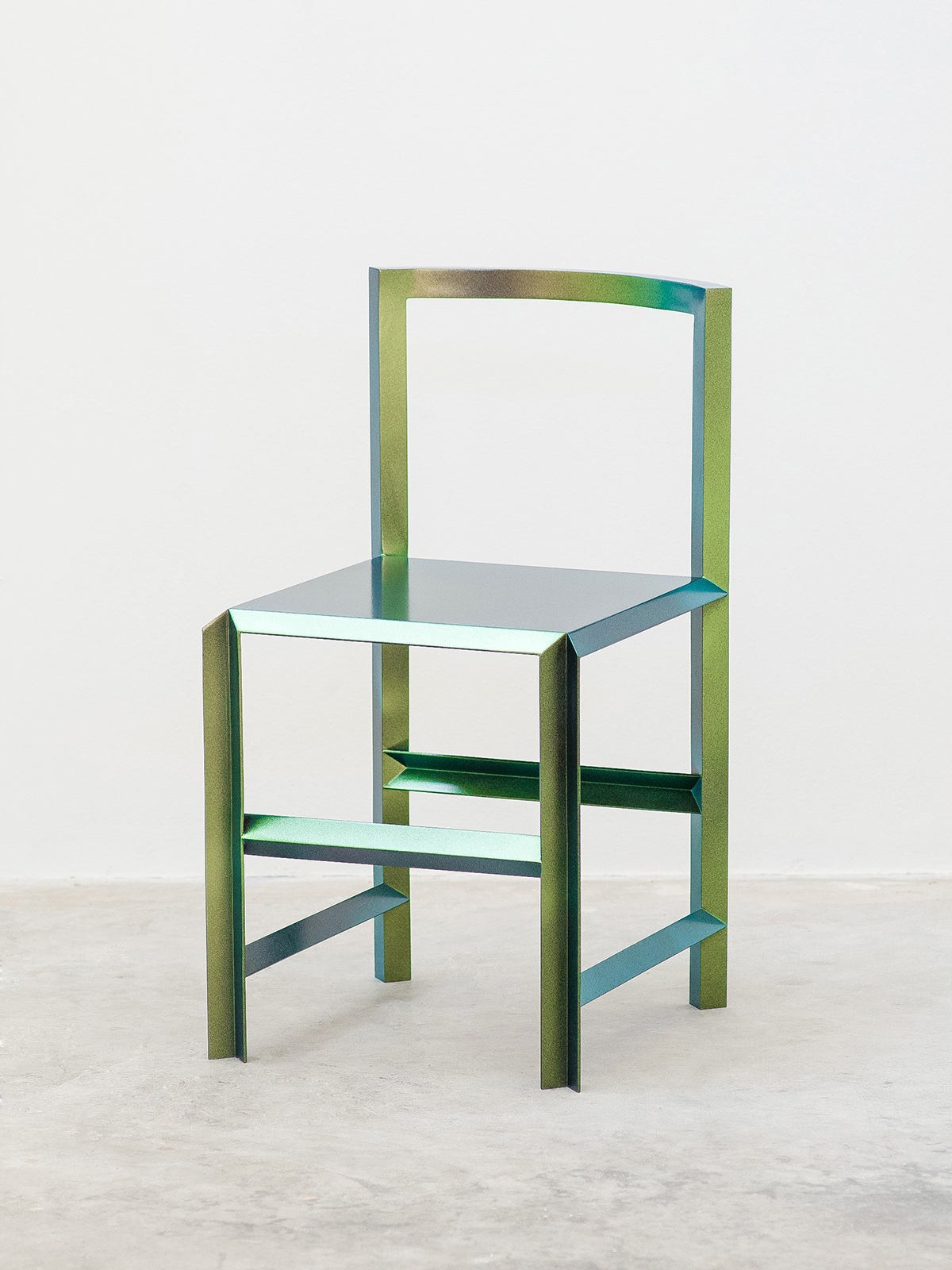
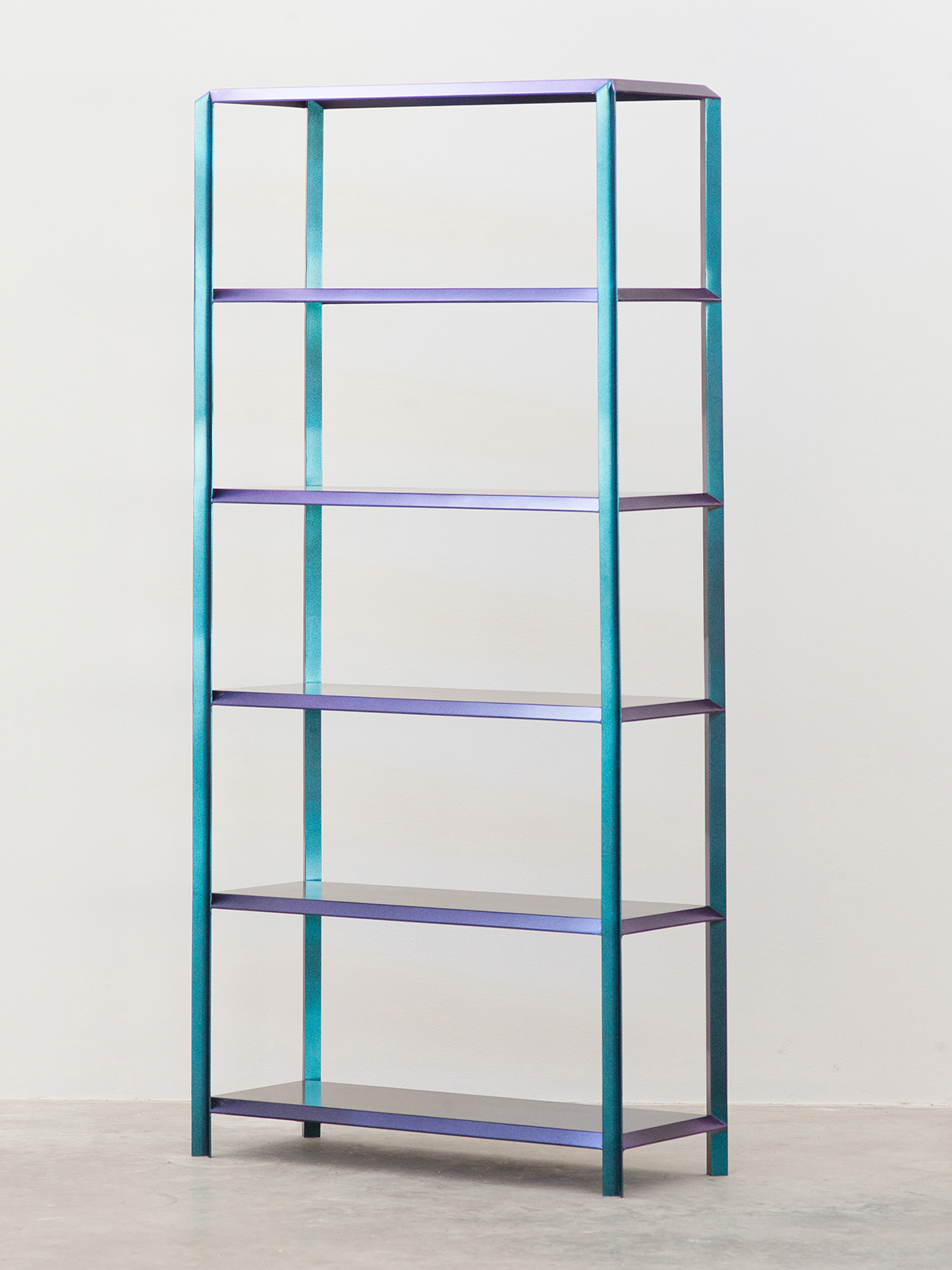
Elle by Marco Campardo
BC: Yes, it seems like you’re often returning to that home, in order to achieve a particular vision.
MC: Right now, it’s very difficult to travel, but yeah, I used to return to Italy a lot because my family is still in Jesolo. The northern part of Italy is known worldwide for manufacturing, and this is why most of my production pieces are made in Italy. You know, these small local businesses, the typical piccolo imprenditore — they characterize the Italian economy.
I’m very careful about what I produce and where, based on the know-how and local materials. For example, when I designed the brick installation with M-L-XL for the Tate Modern Museum, it was an exhibition curated by Bruno Ceschel from Self-Publish, Be Happy. I worked with a UK company that specialized in producing bricks, a quintessential British material. So, what I’m trying to say is that I’m not obsessed with this idea of made in Italy. Attention to local methods and modes of production more than any attachment to a particular area is essential to my work.
HK: How many projects are you generally working on at a time? What are you working on currently?
MC: In general, especially at the beginning of a new project for which I still don’t have an idea, I like to jump between different projects. Of course, I’m trying to avoid facing the fact that I need to find an idea, but also sometimes jumping between different projects allows me to find the idea in a very unexpected way.
I recently started a new adventure with an Italian company as art director, so I’m building a team of designers and craftsmen to create a collection that, hopefully, the company will present at Salone del Mobile 2021. This is very exciting because I can use my experience as a curator, as a graphic designer, and as a product designer to help this company to grow. I was very impressed when I discovered, for example, that Gio Ponti was the art director and one of the founders of FontanaArte. He was involved also in the business part and not just the creative side.
I’m particularly excited because I’m also developing a 4-meter-long sideboard entirely made of aluminum. It’s for my friend, Francesco Poloniato. I mention him because I think he’s the classic example of the rule that good projects need visionary clients who are willing to take the risk with you. Luca, Francesco – we need these clients.
BC: Something that always occurs to me is this idea of a commissioner versus a client. A client creates a kind of hierarchy, but a commissioner is maybe on a similar level. This was a revelation for us. Just switching the word that we used, from client to commissioner.
MC: Yeah.
BC: It seems like you’re interested in creating systems or material explorations that prompt collections as opposed to one-off pieces. How important is that to you?
MC: Of course, I’m mindful of commercial constraints, especially when you’re working with clients. But in truth, I’m not doing systems because I want to work with industry. I’m trying to develop systems because I want to make sure that a thing can be reproduced by someone else. It’s not “I’m designing this joint because then we can do an entire collection based around this joint.” It’s more about creating a system so the result that you obtain is reproducible. If I follow the same process, I will obtain the same result.
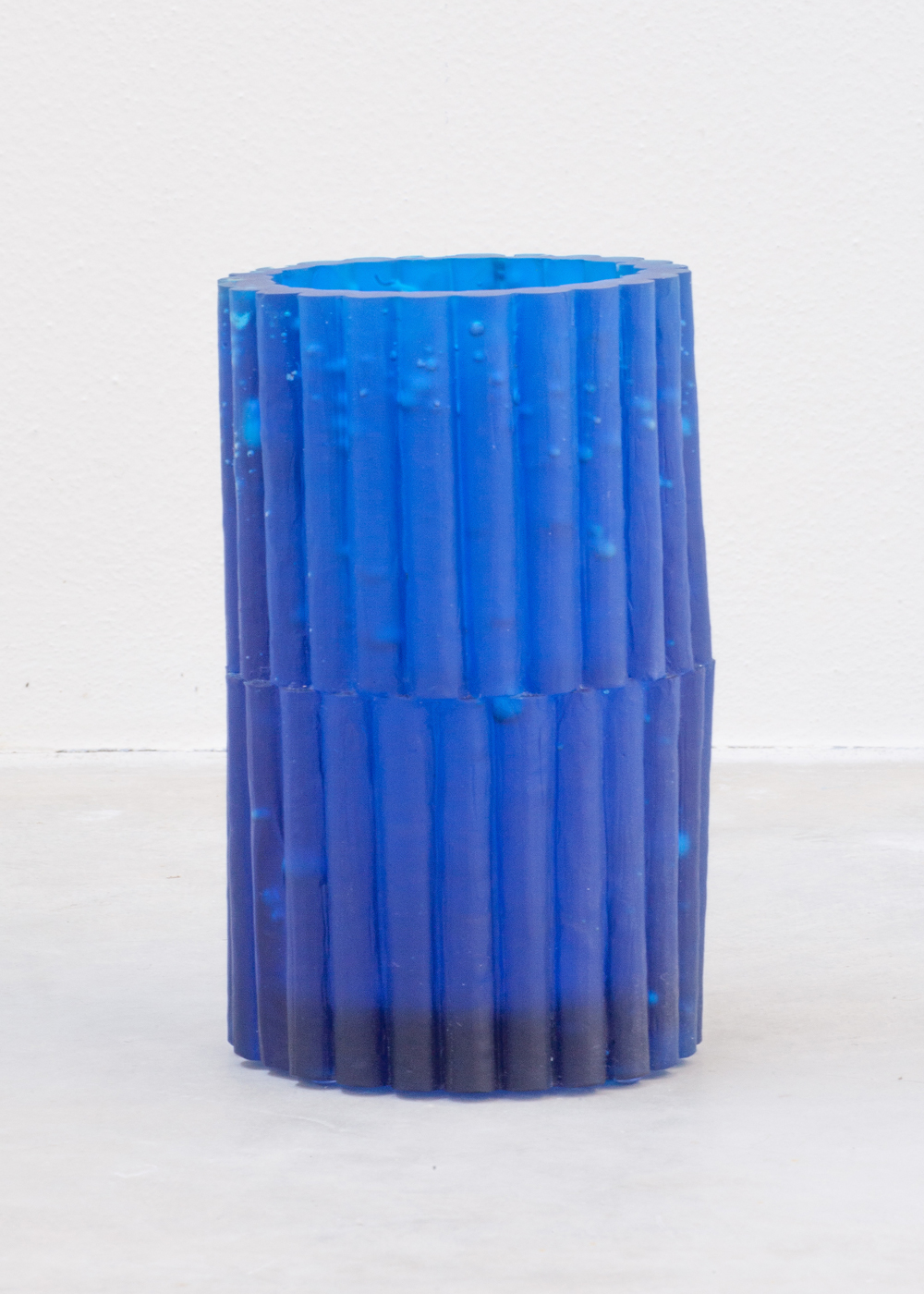
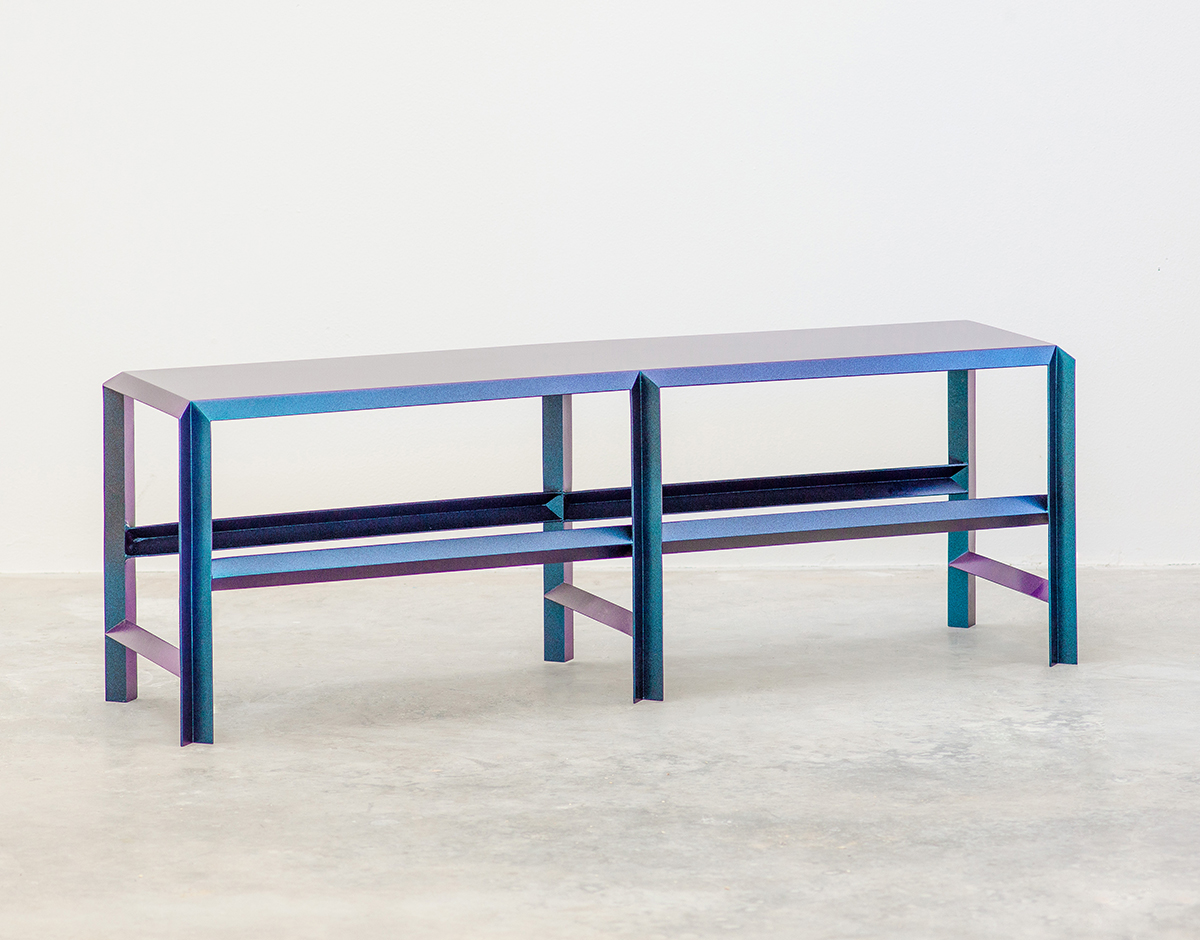
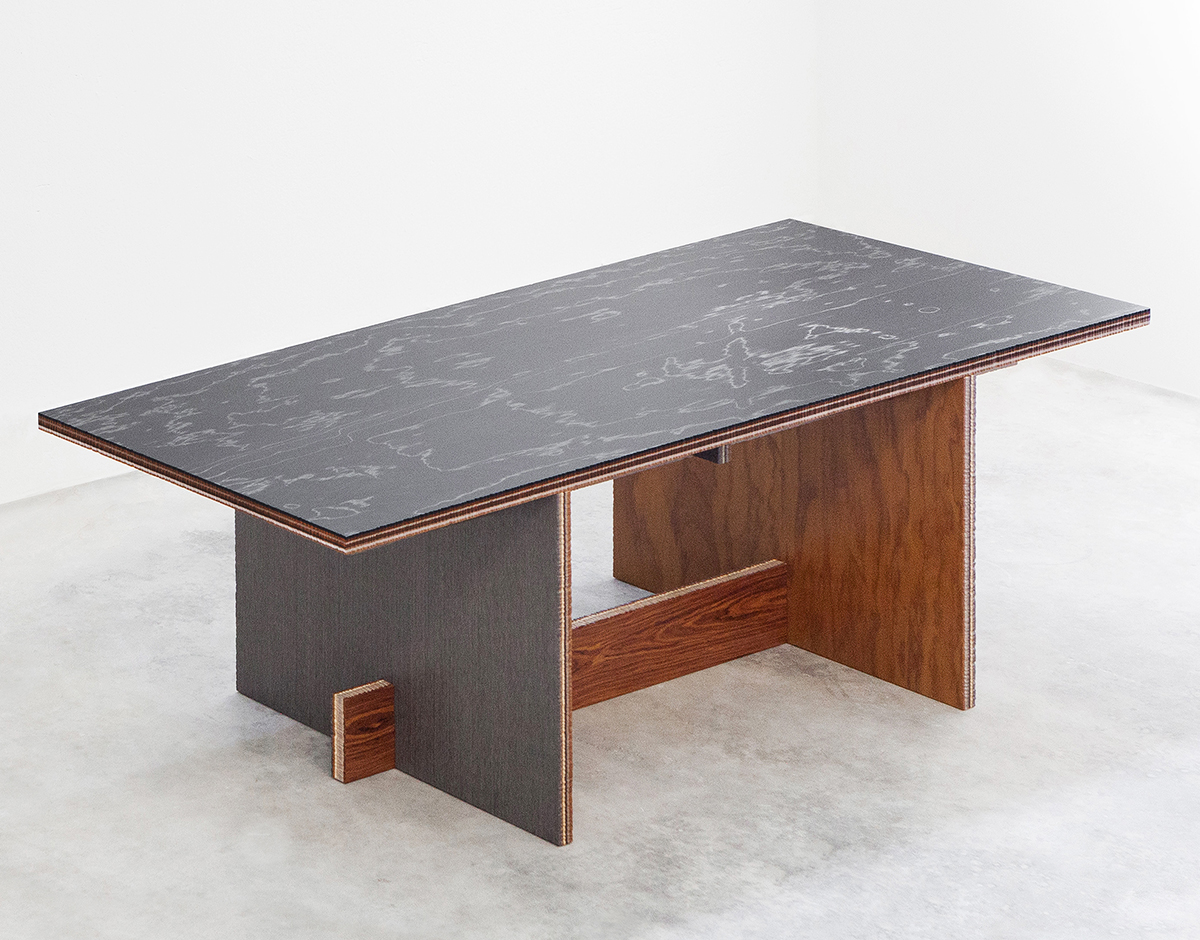
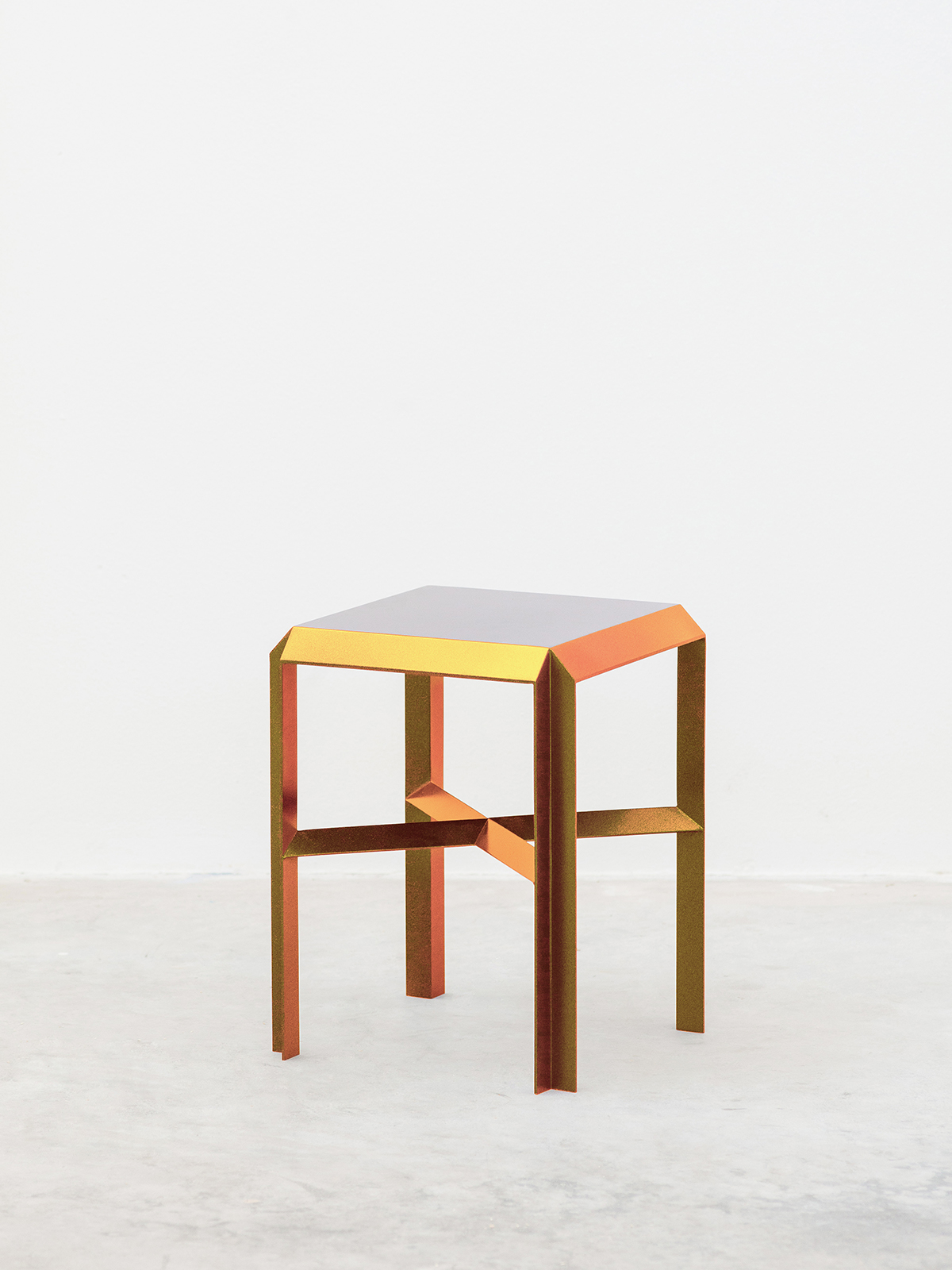
BC: That’s really interesting to us because we often think in systems as a way to test our own ideas. To be like, okay, great, this works for one thing. Could it work for something else? There’s a value proposition in saying, oh, wait, this good idea is actually scalable. It’s not a value proposition in actual money. It’s an intellectual value proposition of saying that this great idea can be applied to a number of different settings or to solve a number of different problems, as opposed to just the one problem of a chair.
I also have to ask myself if I’m interested in systems because of my background in graphic design. I think Heidi is more open to a piece that is a gesture. It’s on its own. It is solo. It’s a great thing, and it can happen once, and that’s okay.
MC: In that sense, I’m exactly the opposite.
BC: Right. Heidi and I are great, because I’m always thinking in these systems and Heidi says, ‘Hey, what if it’s okay to stop the systematization?’ When we made the shelving system, for example, we were interested in that being modular and able to translate into seating or into a bed frame. It’s not about working with a larger company or for commercial viability. It’s just to put the system to the test.
MC: Thank you for this. You made me understand why I do things in a certain way.
BC: Of course. Does it help at all?
MC: I think, so, she is the one that is trying to make the chair float.
BC: Maybe, yeah.
MC: You are seeing it with the four legs.
BC: But I’m open to two legs, as long as the two legs come from a really rational place.
MC: So a chair with two legs plus your two legs.
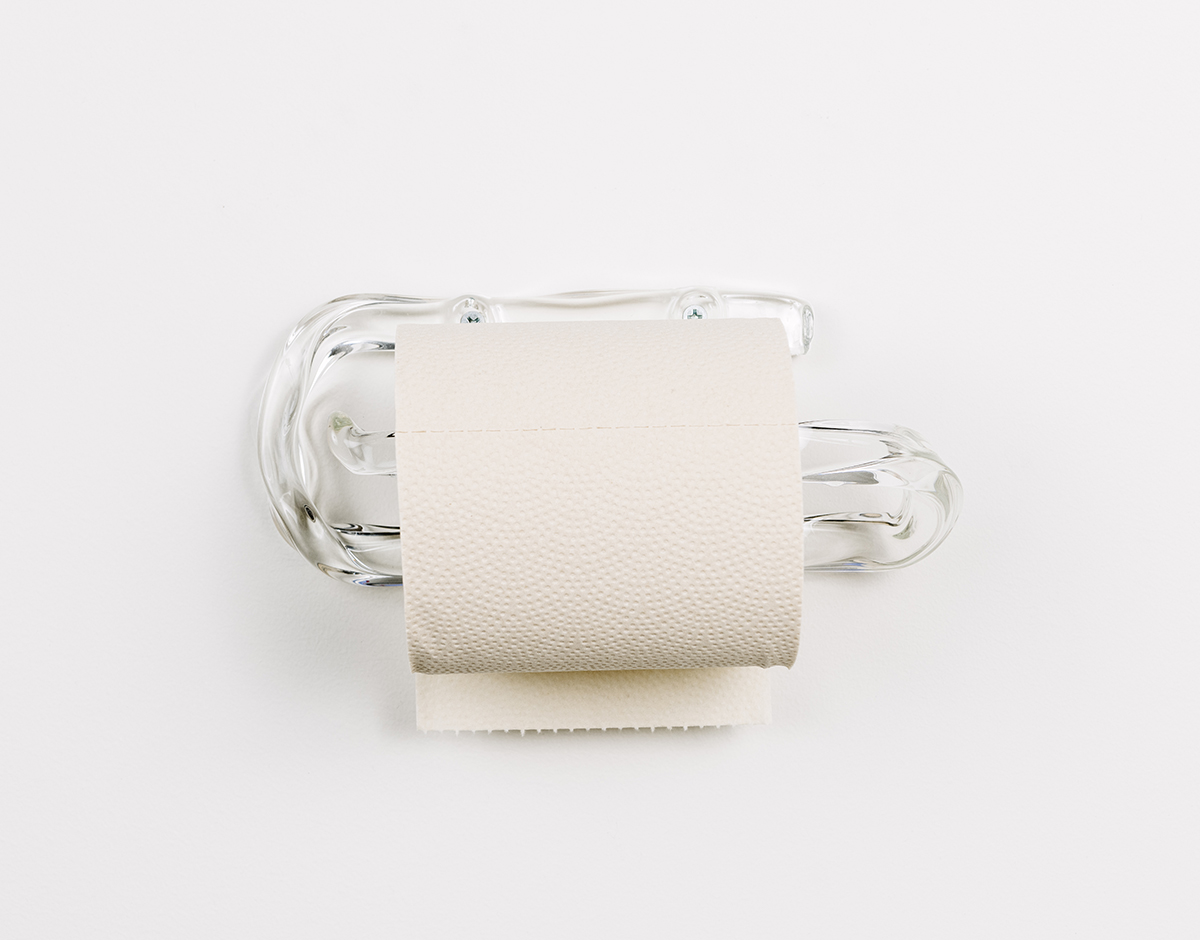
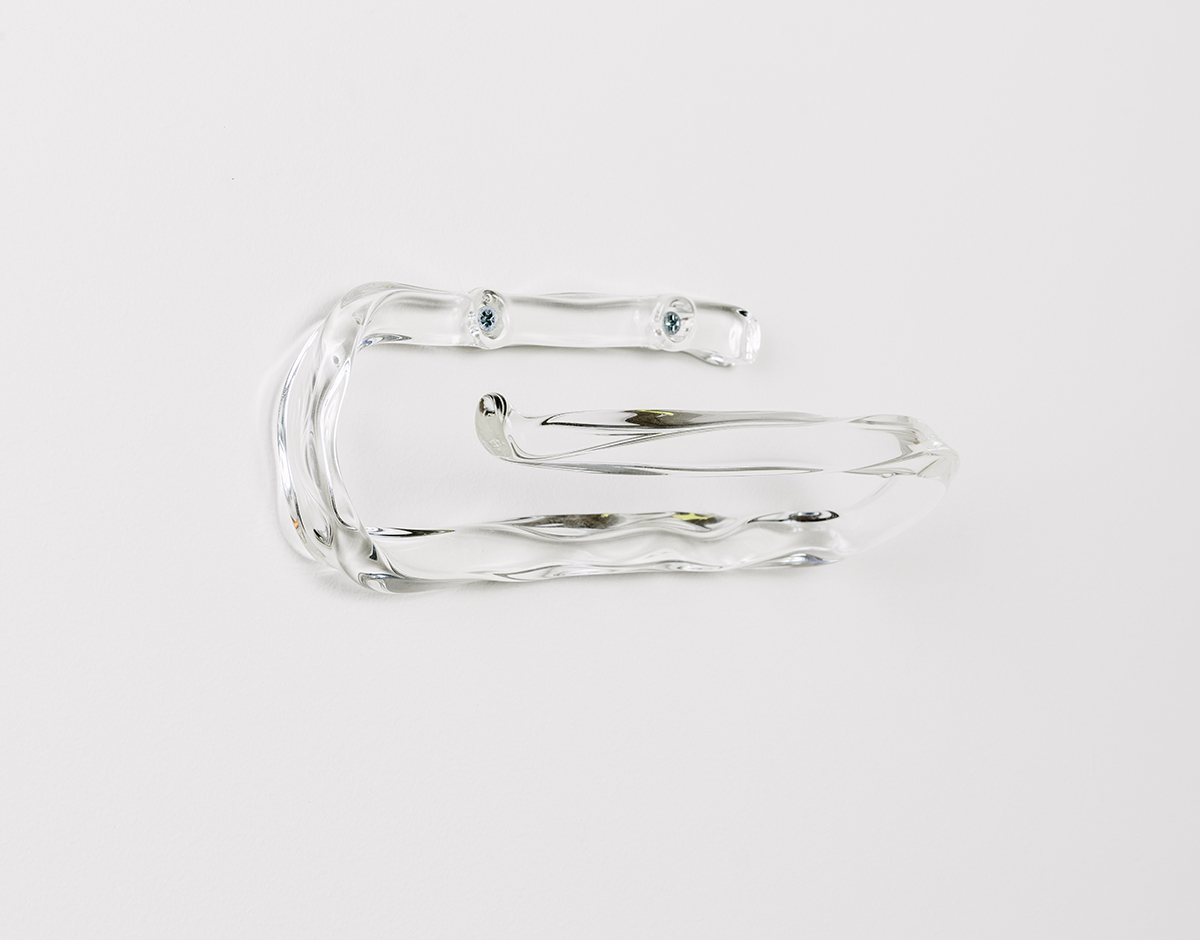
Toilet paper holder for Marta
BC: Exactly. It seems like, for all this thinking, though you work very quickly. When we did the toilet paper show at Marta, yours was the first to come in.
MC: Yeah, but that was luck. I was in the middle of lockdown. Everything was closed. I received a call from Jochen for other reasons, and I said, Jochen, can I come to your studio and we spend, like, an afternoon together? Sure. The day after, it was ready.
BC: That’s amazing, because that seems very intuitive.
MC: Sometimes, it’s ready to go. Sometimes, you have to struggle. I don’t consider myself fast, but I consider myself aggressive. When there is a new project, I really try to concentrate, to focus on it. I’m not a last-minute guy.
HK: Have you used this time at all to think of the various futures of art and architecture and design fairs?
MC: Tricky question. Of course, there is a lot to criticize about the system of fairs, but after a year in lockdown, I have to say, exhibitions and events are such an important part of my life, not just professionally, but personally. I cannot wait for a normal design life to restart.
I really miss using the rest of my senses. I need also to touch and smell things. I need to experience a life that is less digital.
BC: Yeah. Even for us, we thought we were doing fine during quarantine, and then we opened a new show in January here at the gallery. It was such a revelation to let people into the space again and to have conversations that you didn’t know the outcome of. For the opening, we made cocktails for people to take back to their houses. So, yes, we tried to address that taste part of the equation, but no, there’s nothing that can substitute for the real thing.
MC: I am very old fashioned, I like real things. I like to look at something and appreciate it for what it is. It seems like people are making whole portfolios through digital representation, and then nothing is made. To be able, at the end, to obtain something, you have to go through the entire process. That sounds very banal. But that’s the thing. If you go through the entire process and you get the object, it’s completely different. The rest is simply a representation of something.
Of course, it is reality. It exists. I can see it. But, I cannot sit on it. I cannot touch it. I’m more interested in the real experience right now, processes that are created with materials.
BC: Yeah, and with a real, well-resolved object, the photograph makes itself. You don’t have to make a particularly excellent photograph because the thing is already there if you light it well.
MC: Is this a suggestion for me to make better photos?
BC: It is not. It definitely is not, because I find your photos to be quite good, but what you’re saying, or at least as I’m reading it, is the photos are good because the pieces are good.
MC: I can’t say that.
BC: No, I know, but I’m saying that.
MC: Guys, I don’t want to put you in a very uncomfortable position, but today, it’s my birthday.
BC: What the fuck?
MC: Yes, and I’m 39, and it’s incredible how am I starting my 39th year of life. So, thank you so much, guys. You made my day.
BC: Amazing. Happy, happy birthday. I wish we could celebrate you more meaningfully or have a drink together.
MC: We have two bottles of Champagne ready to go.
